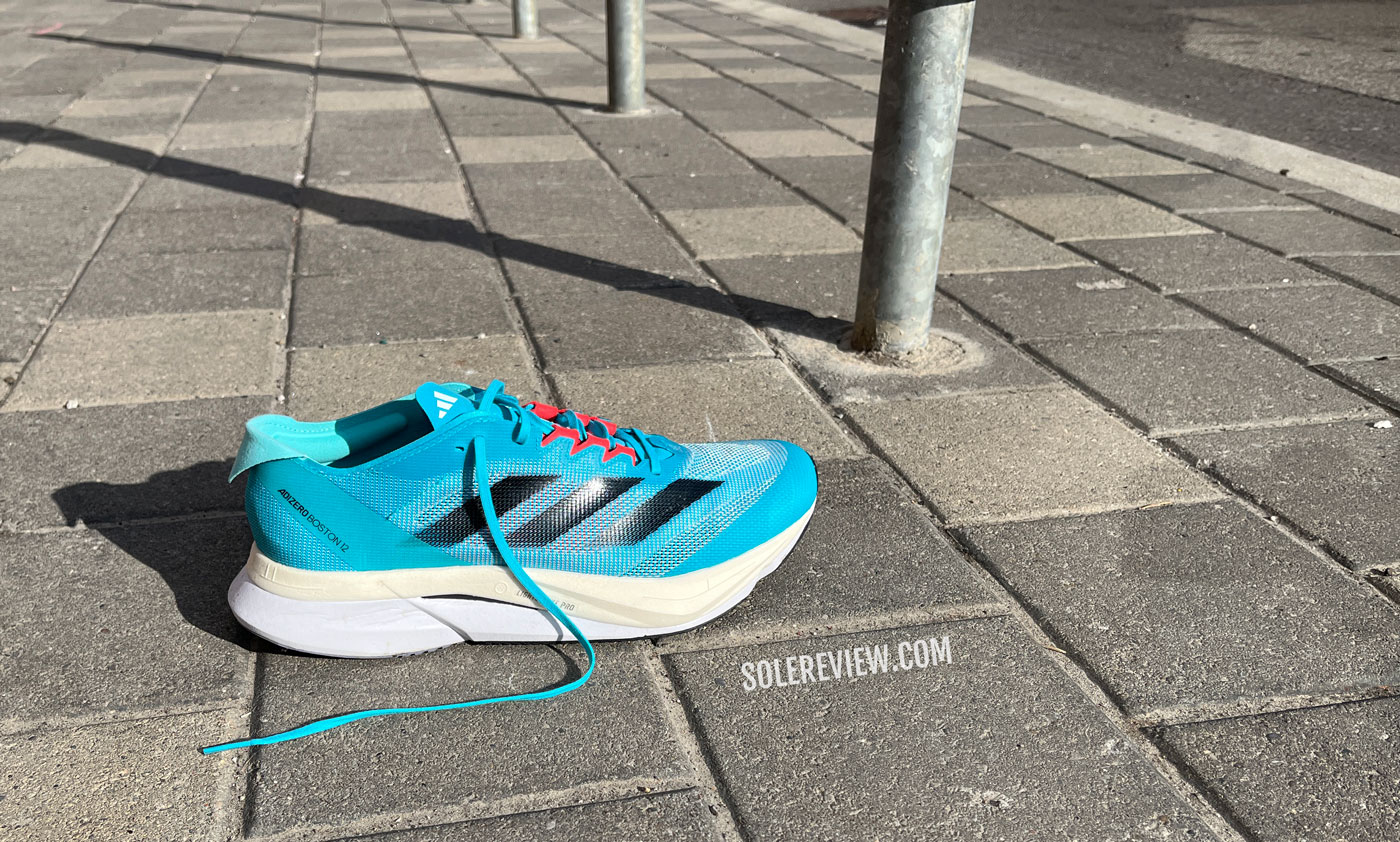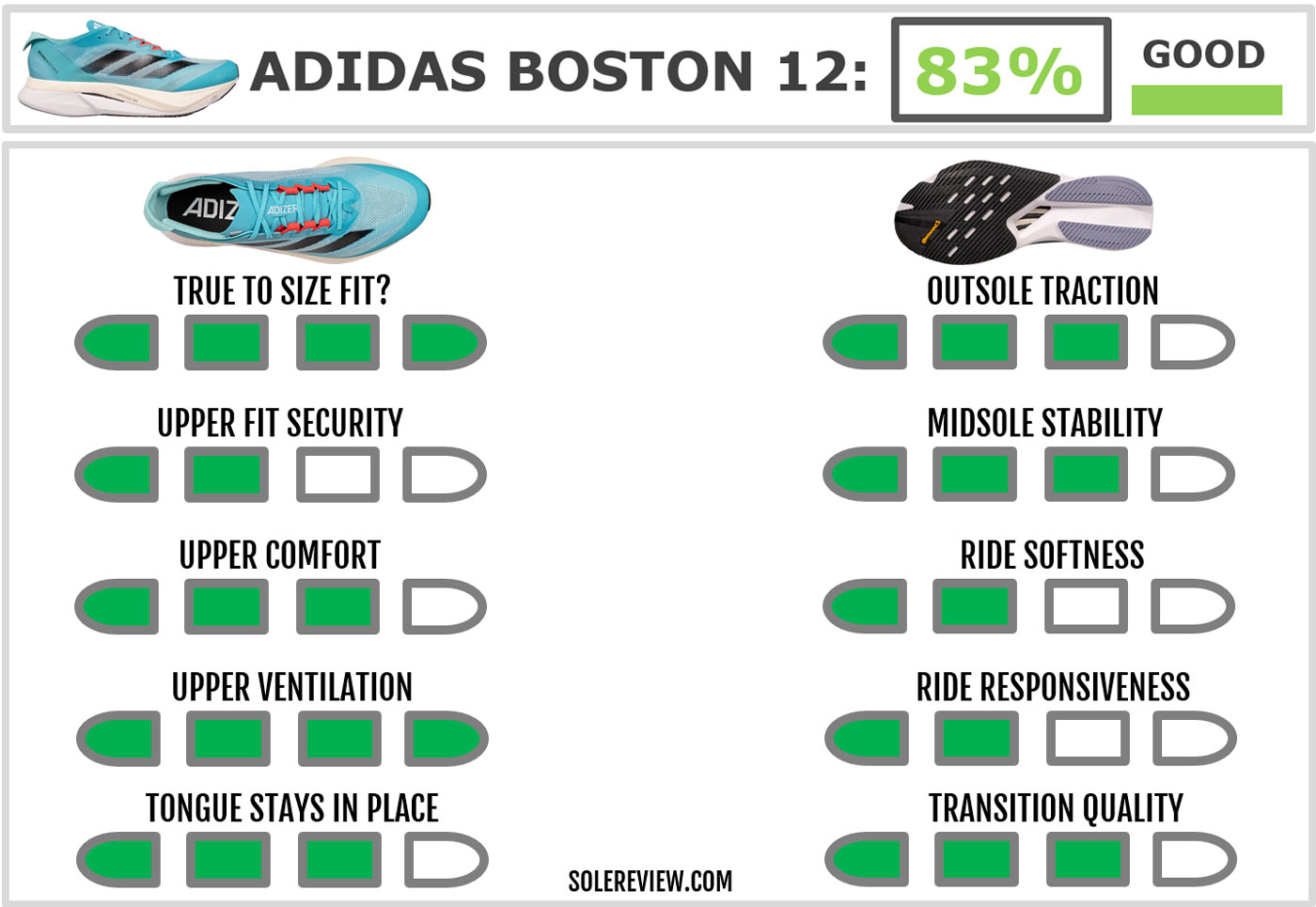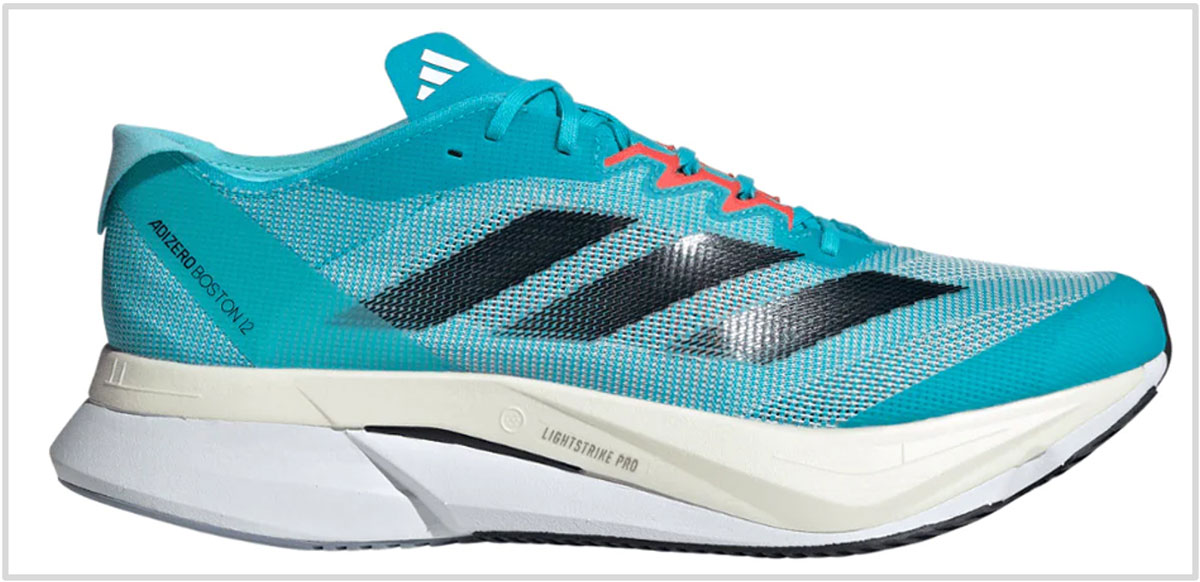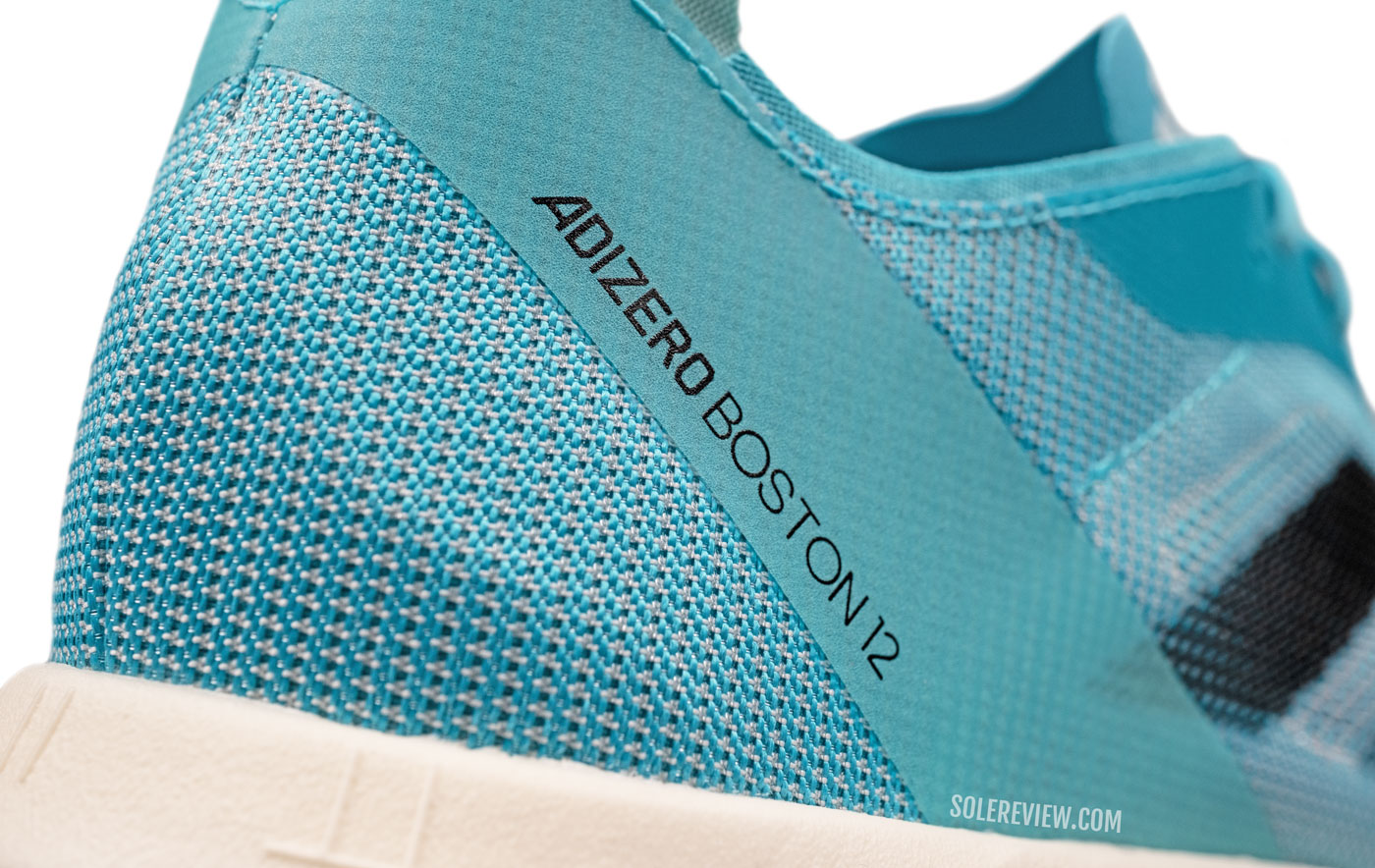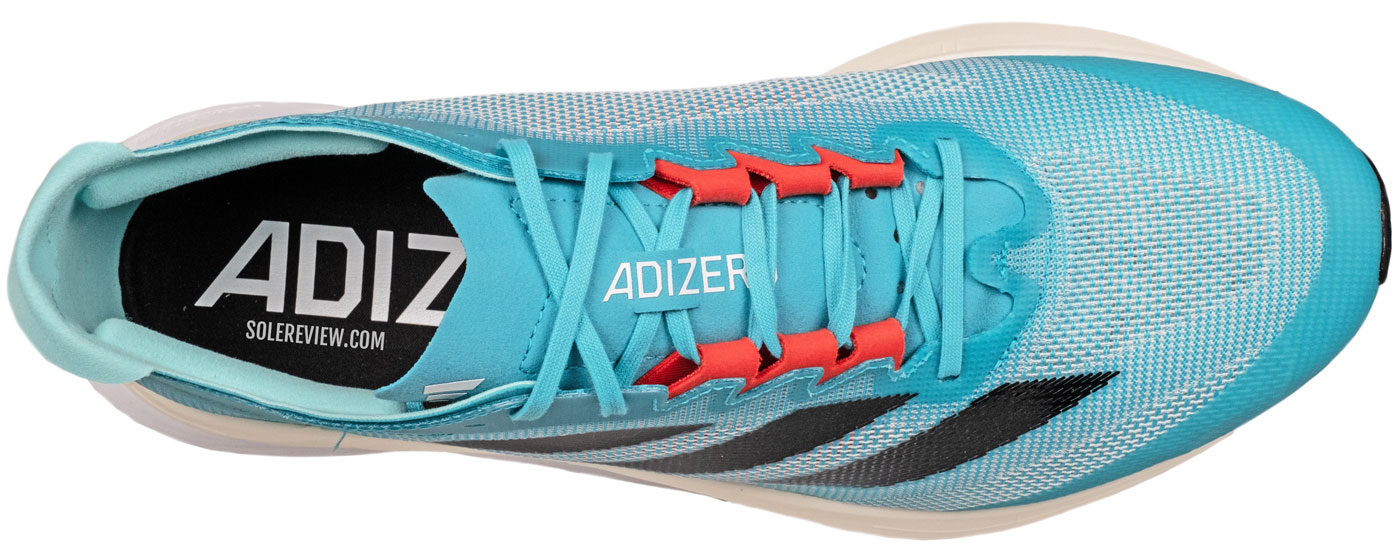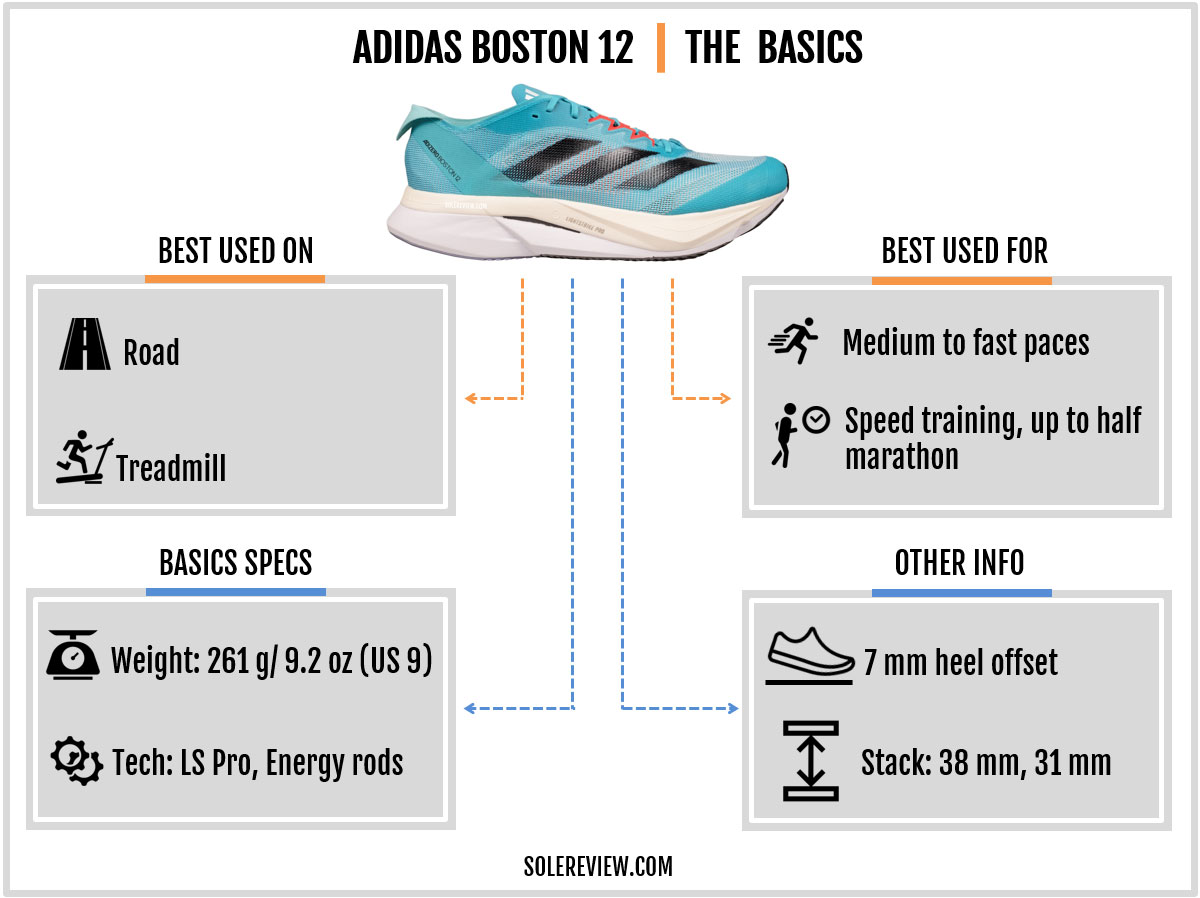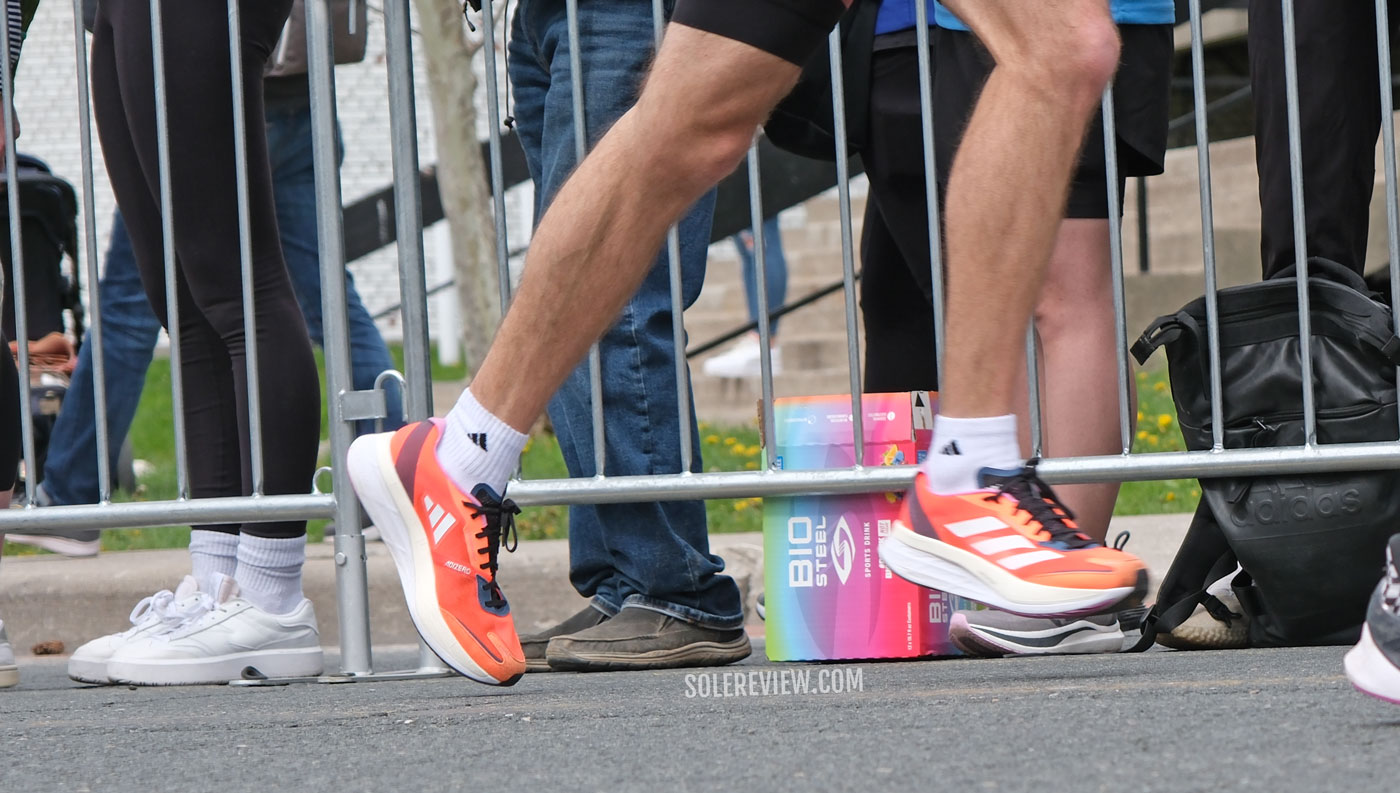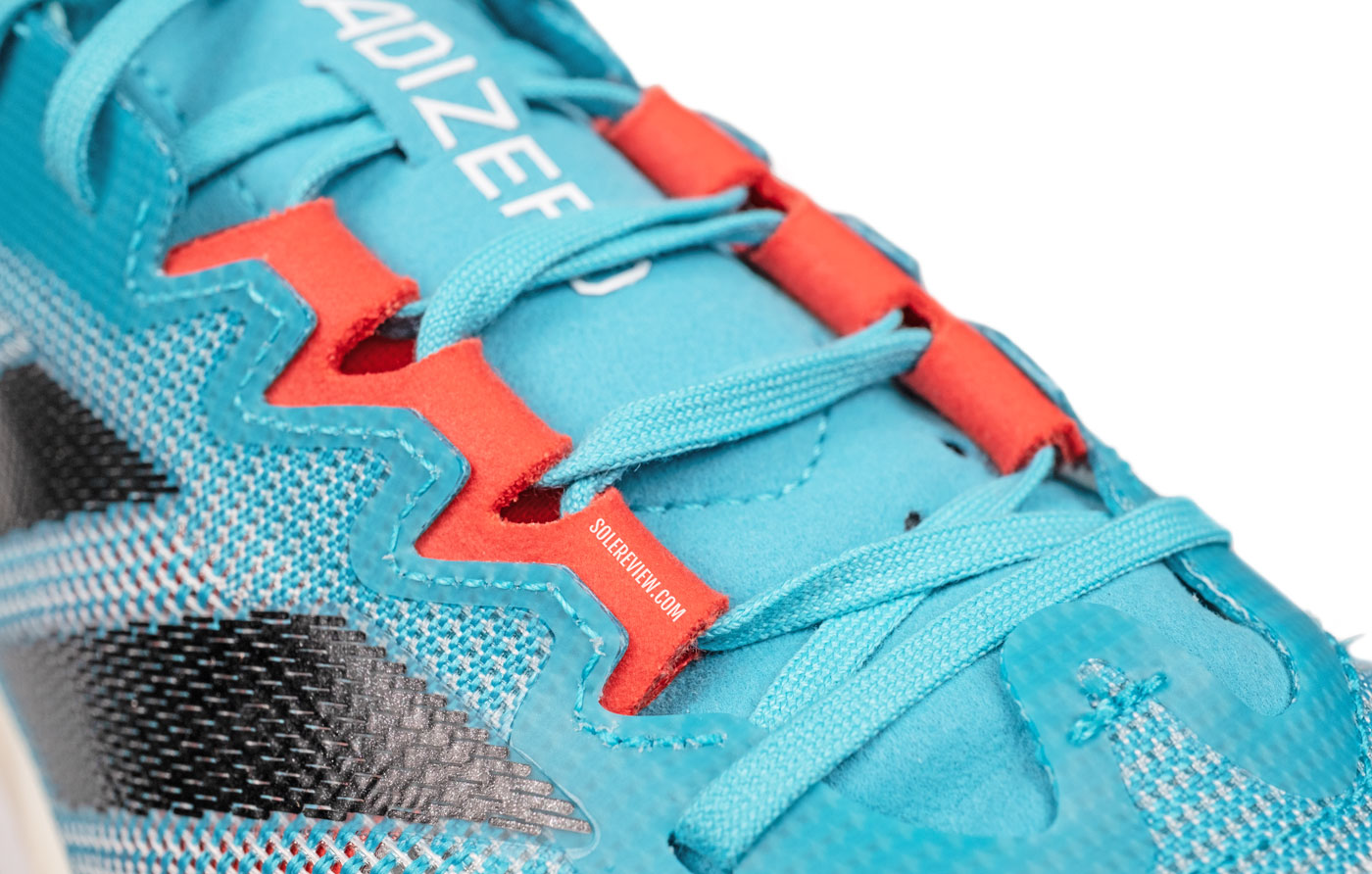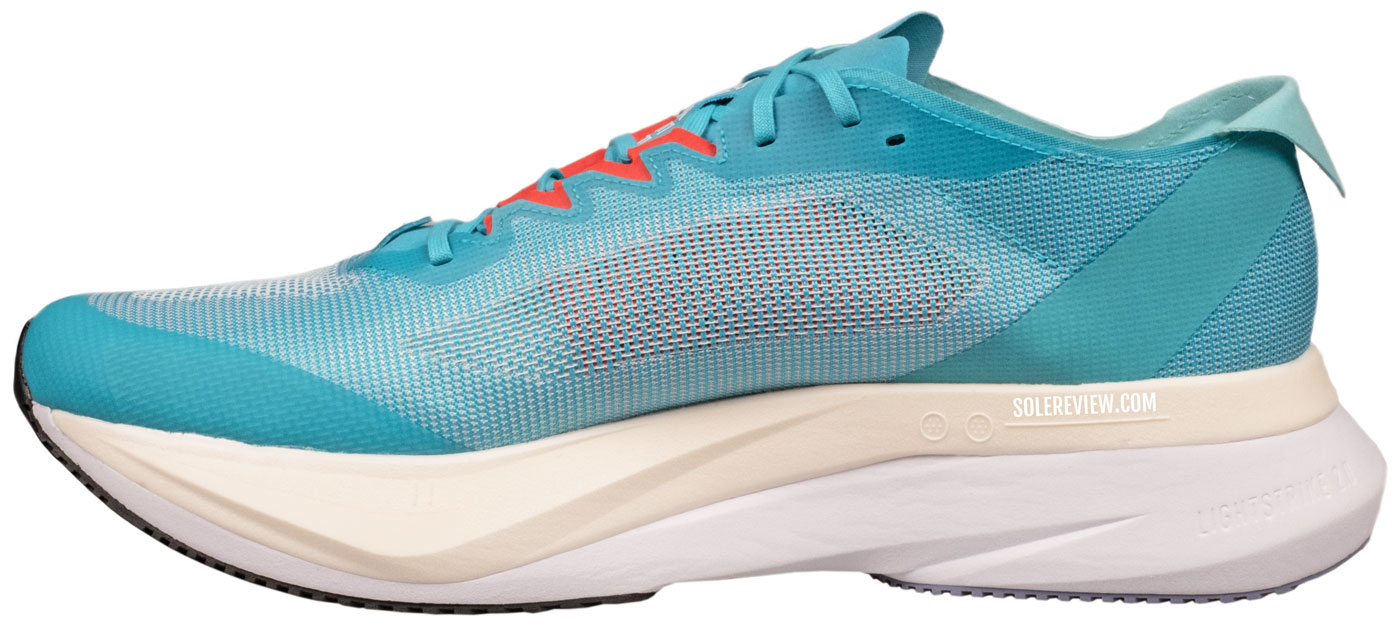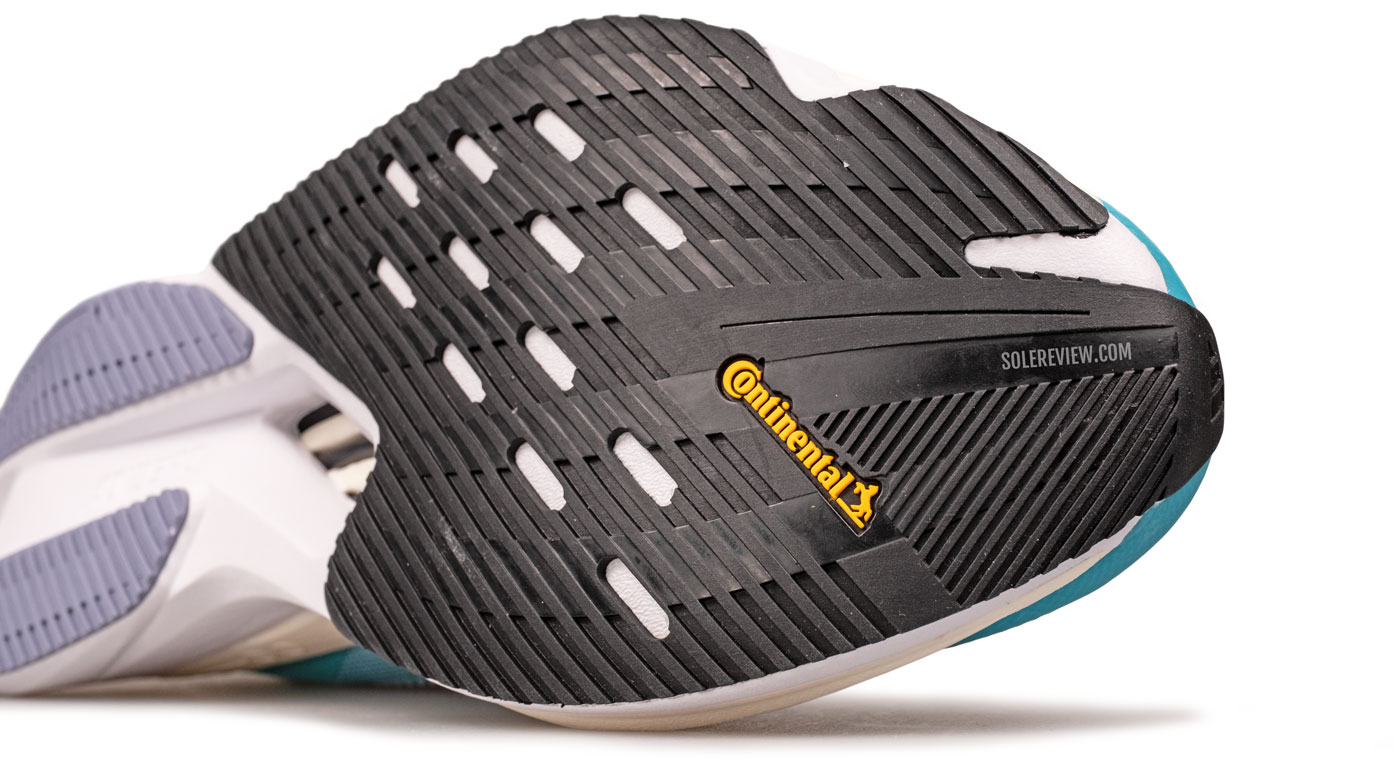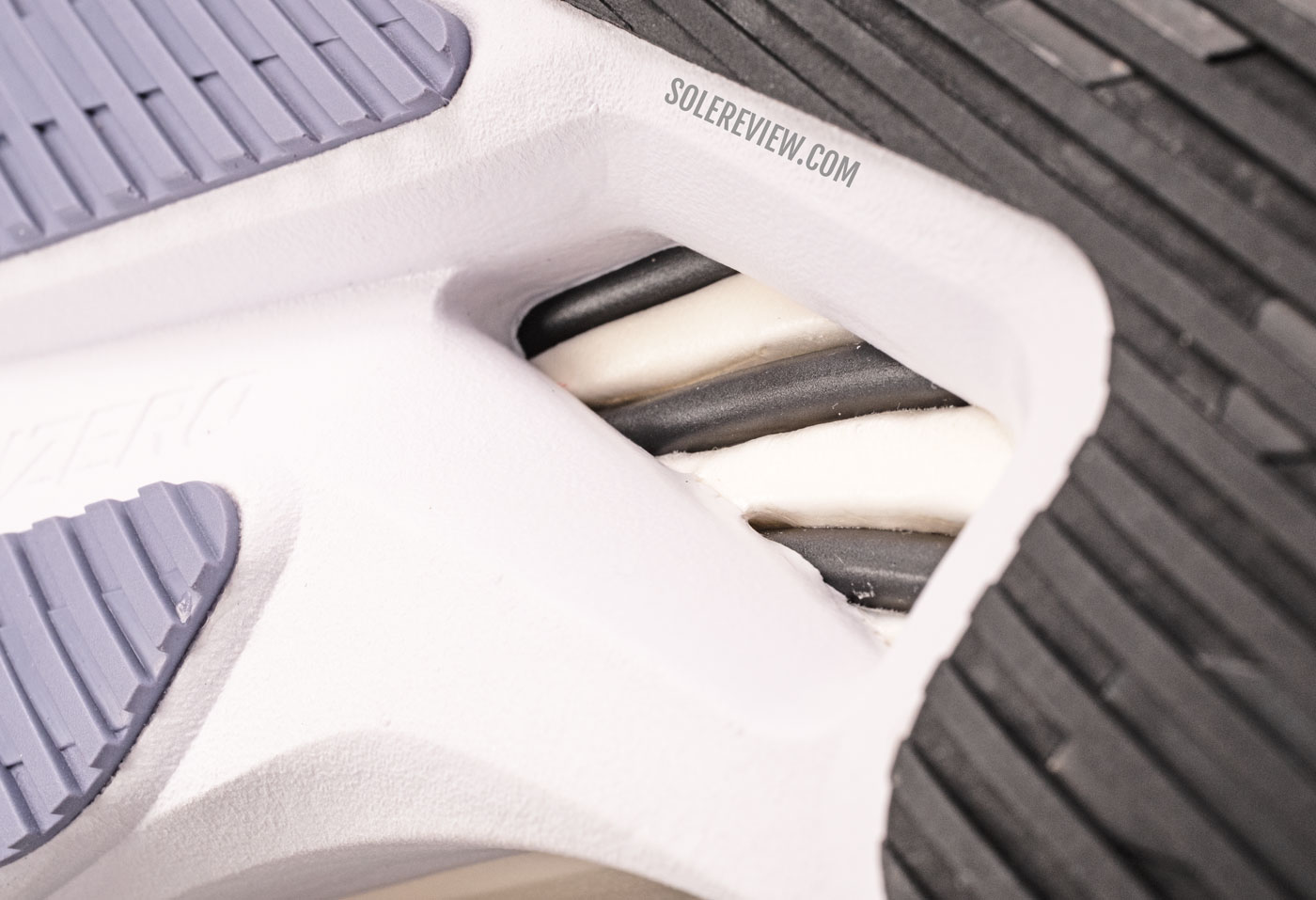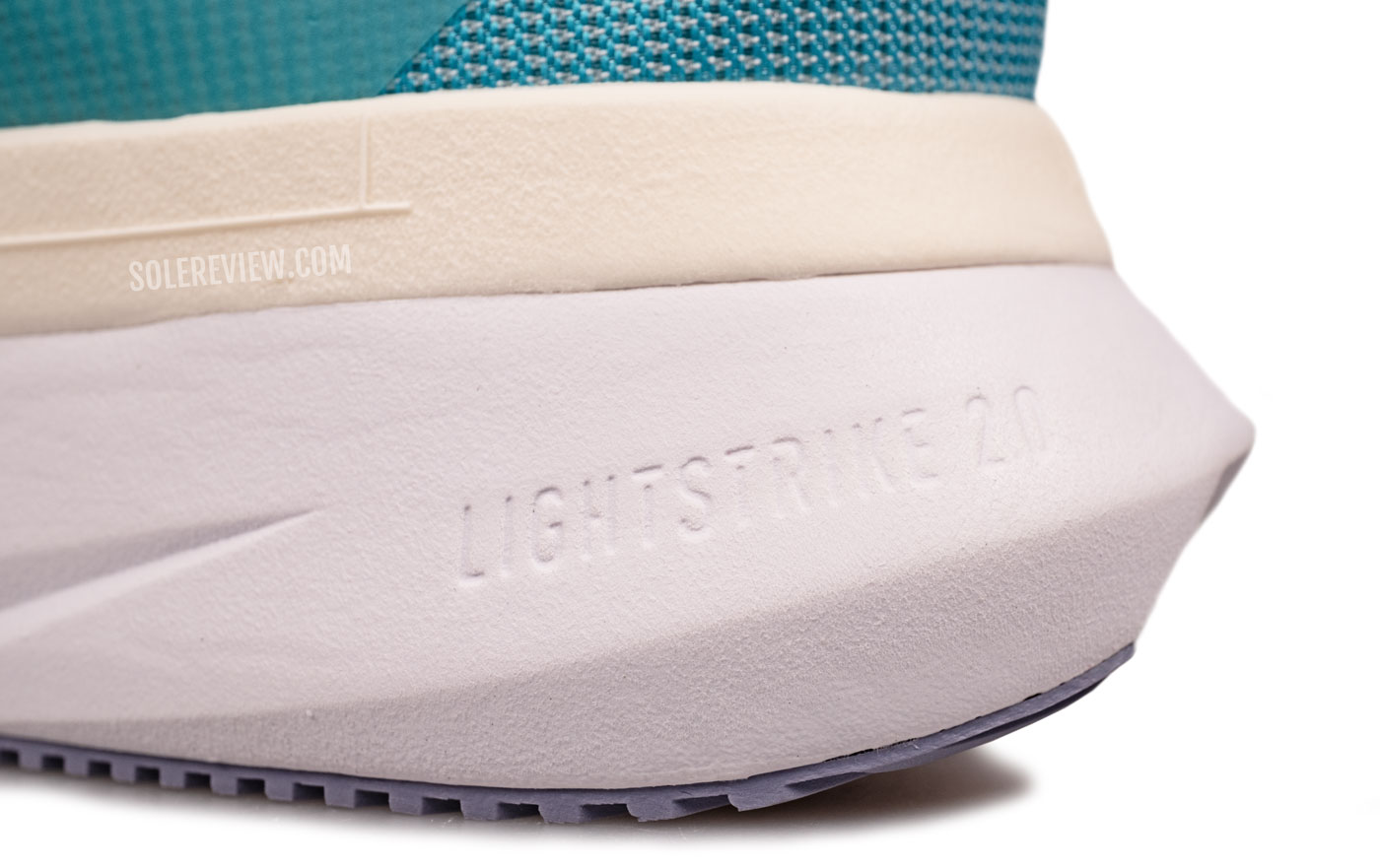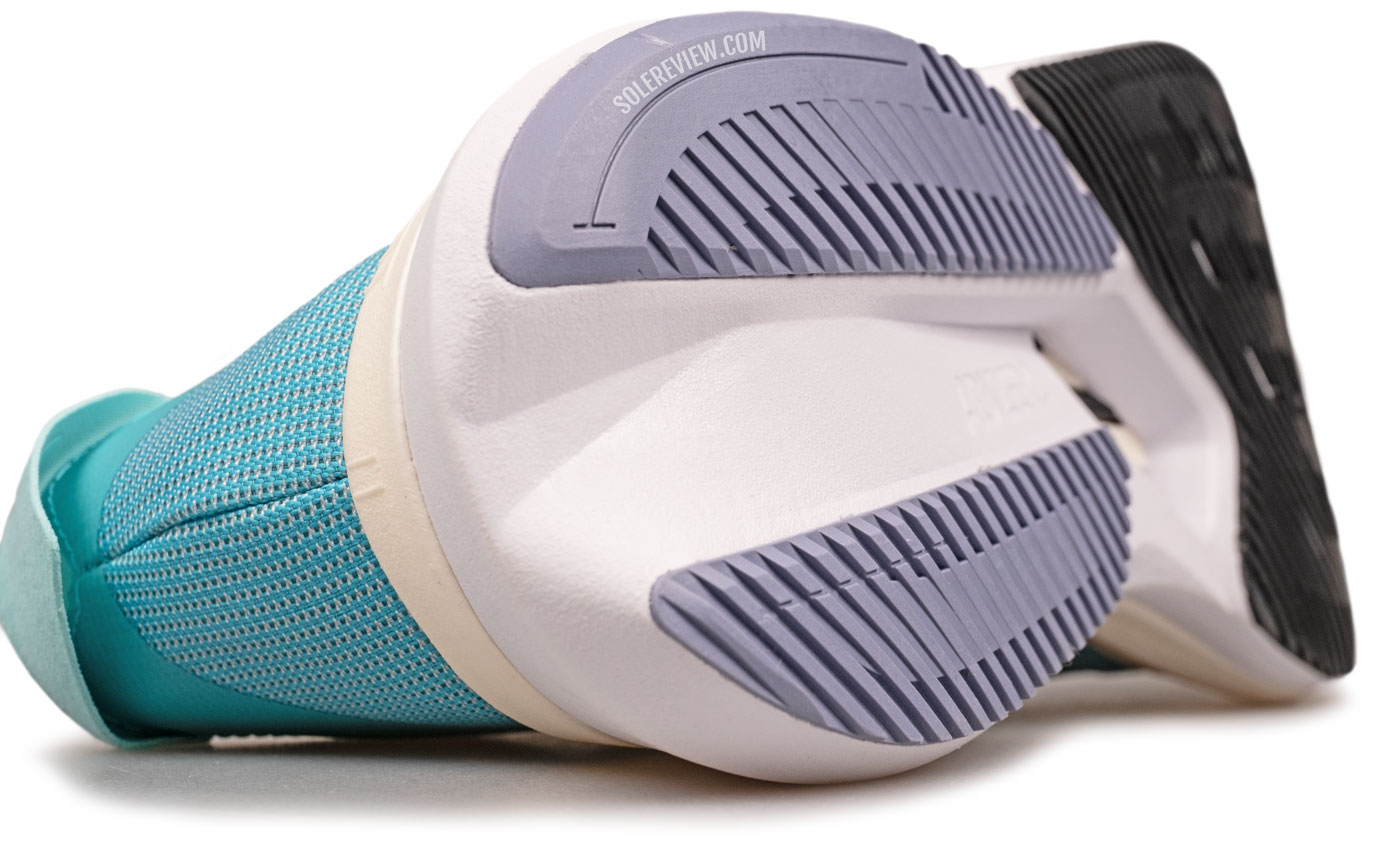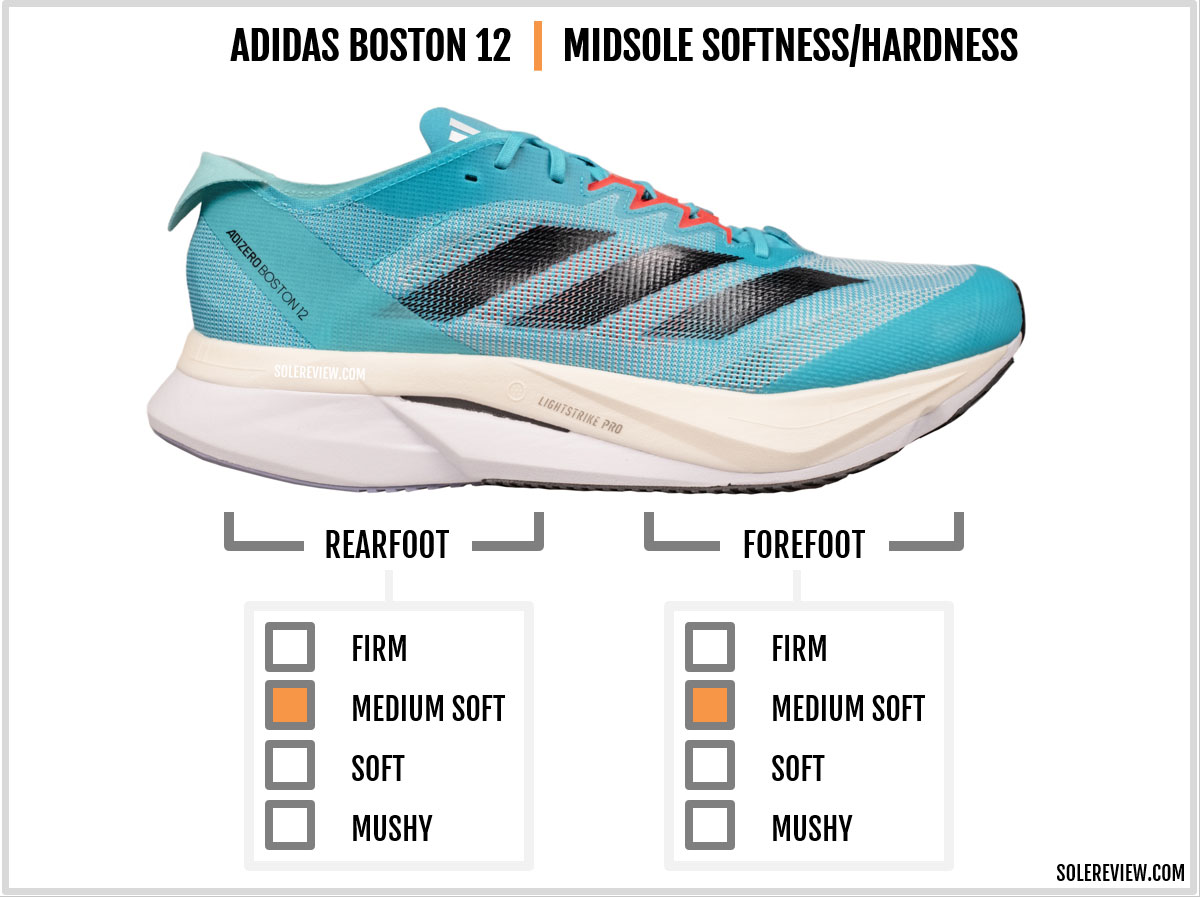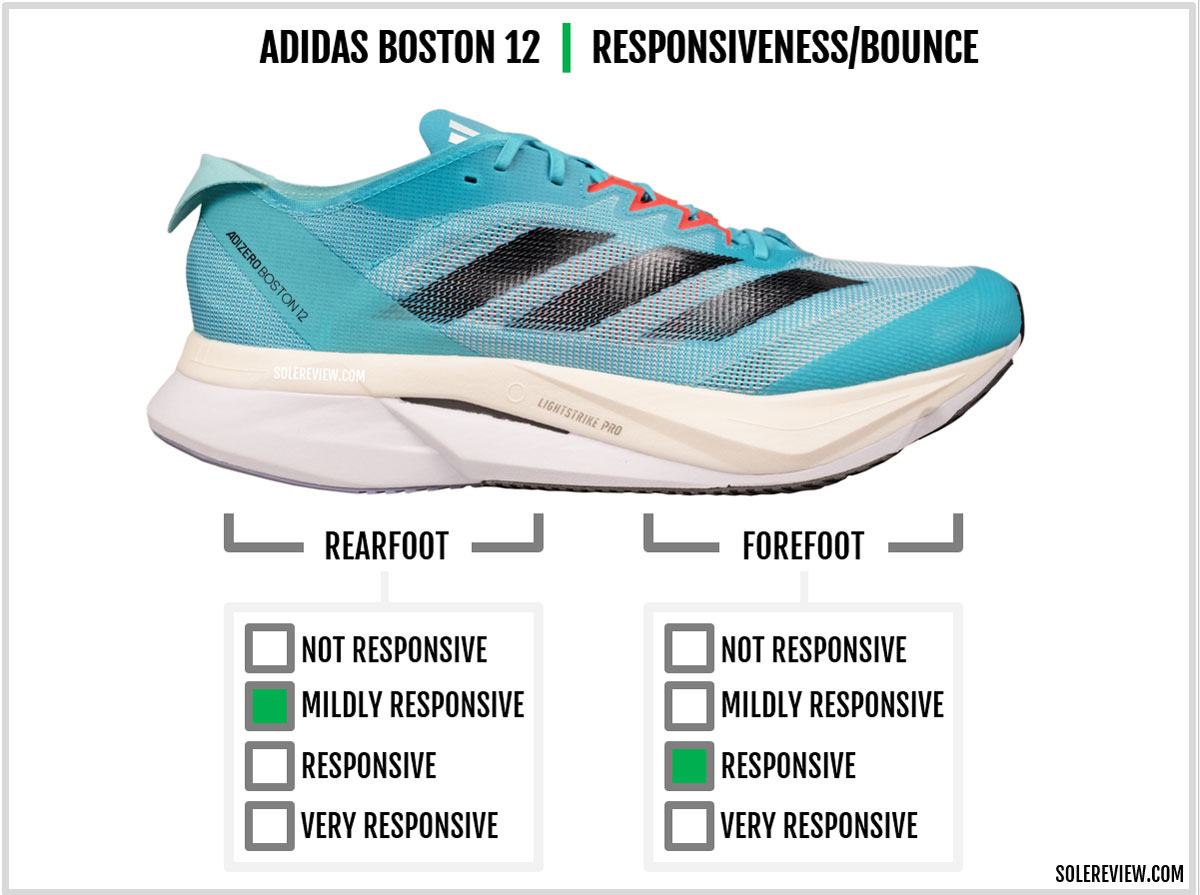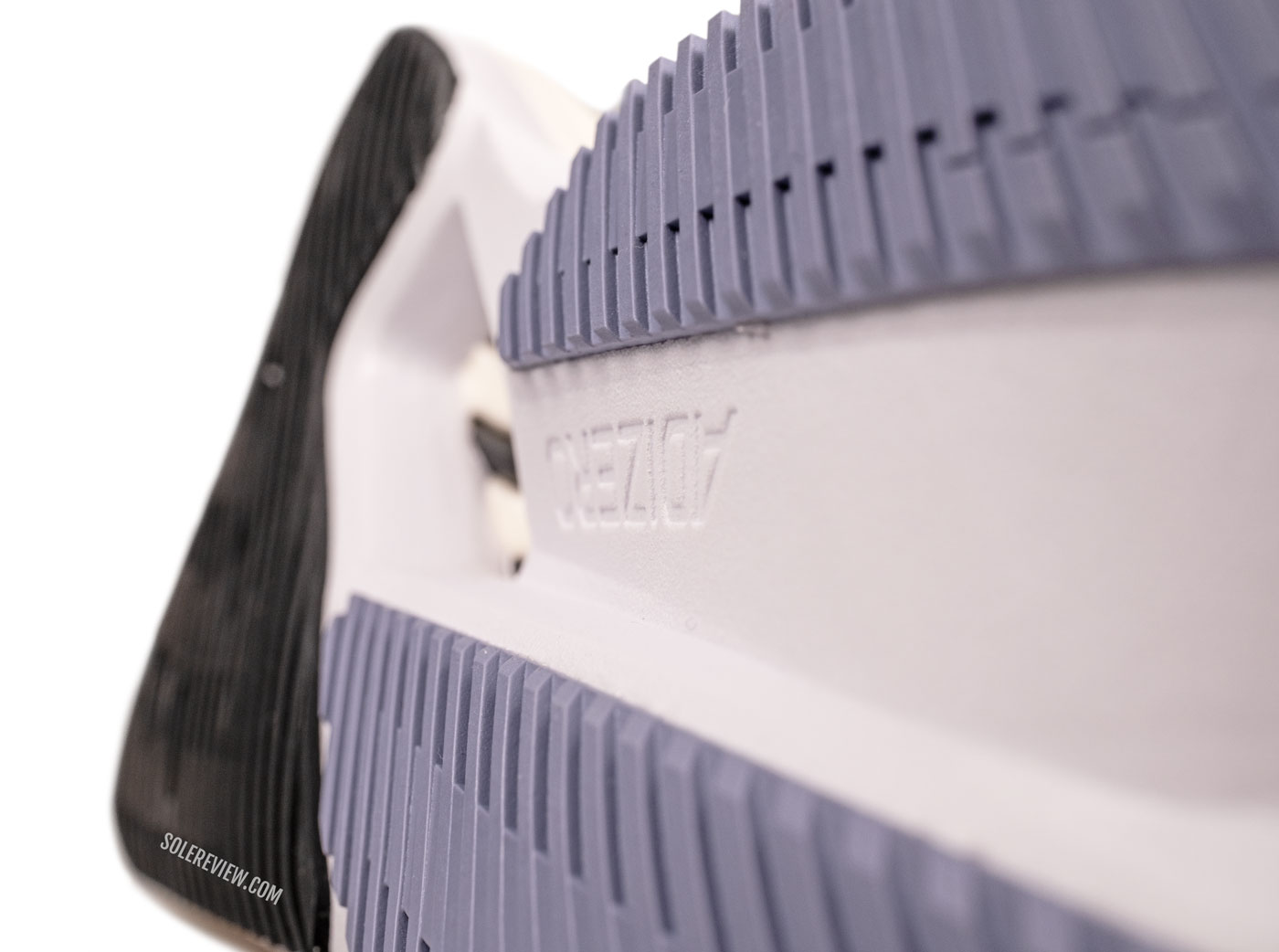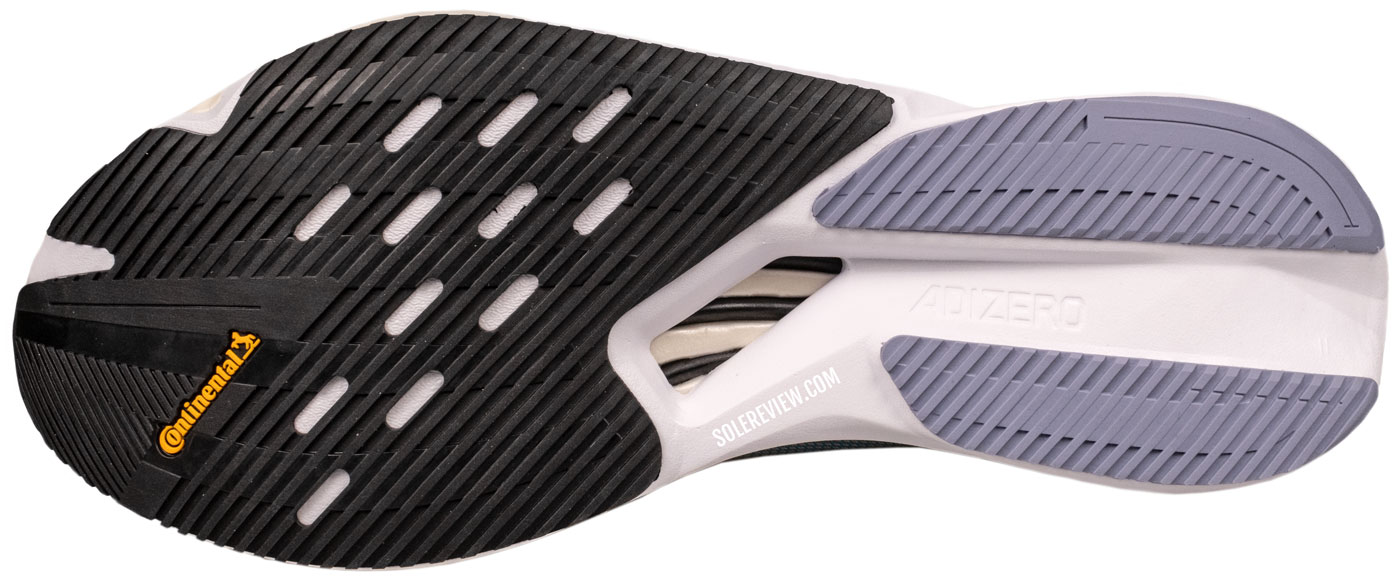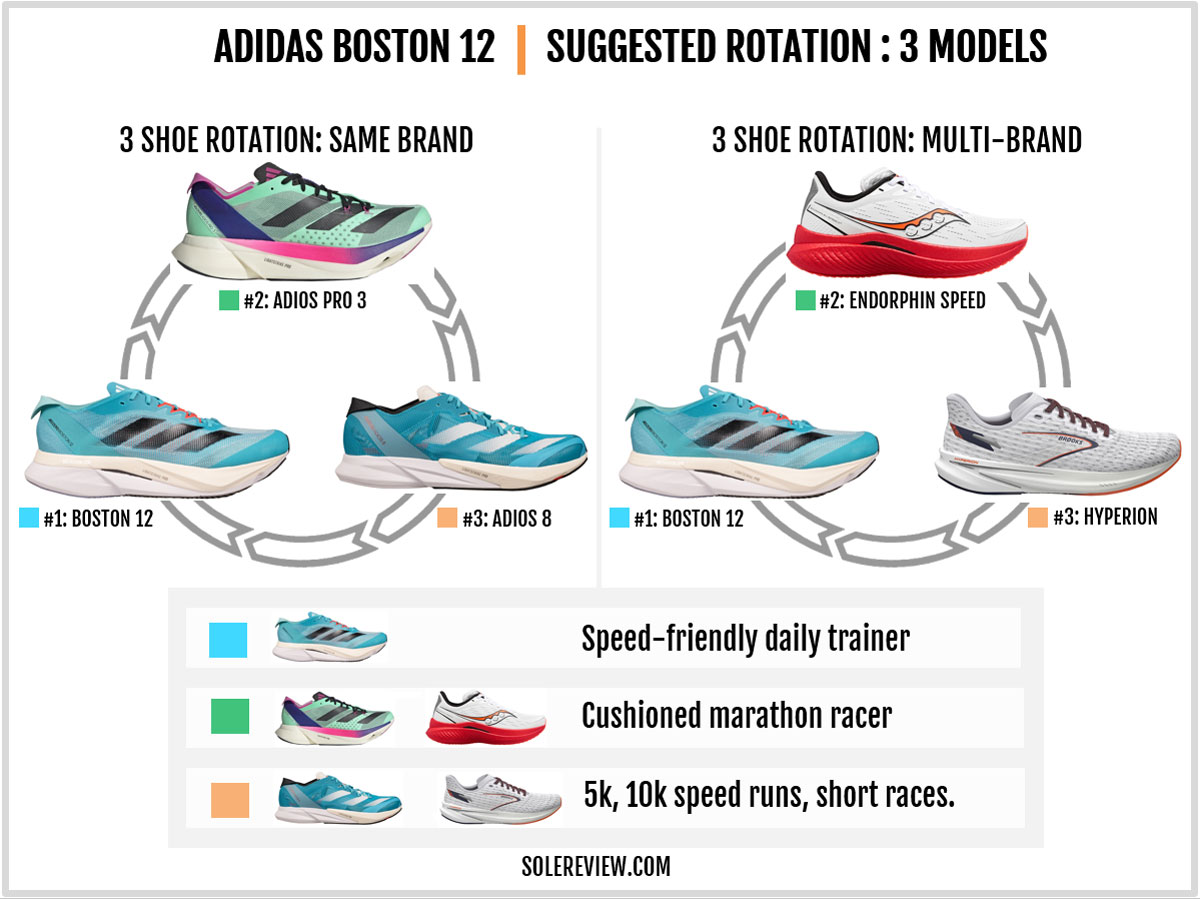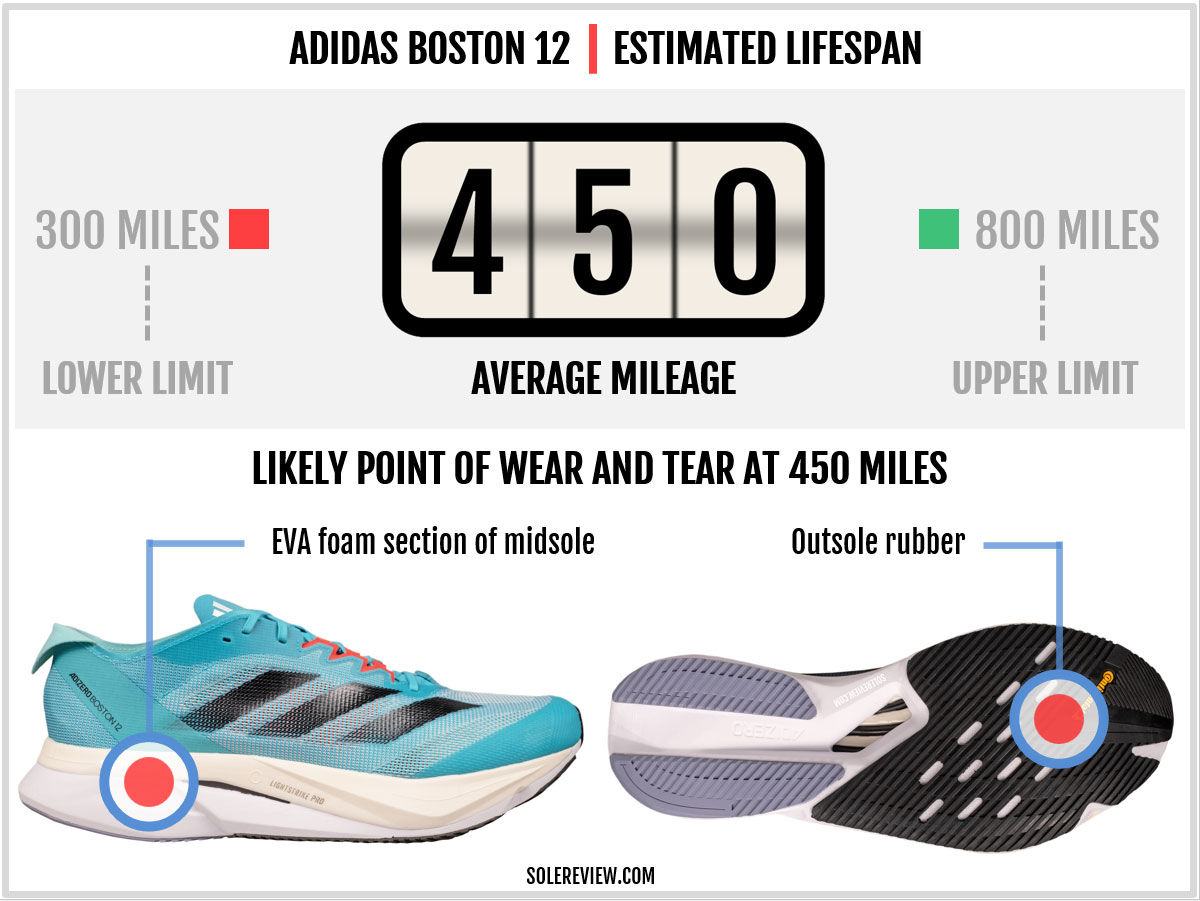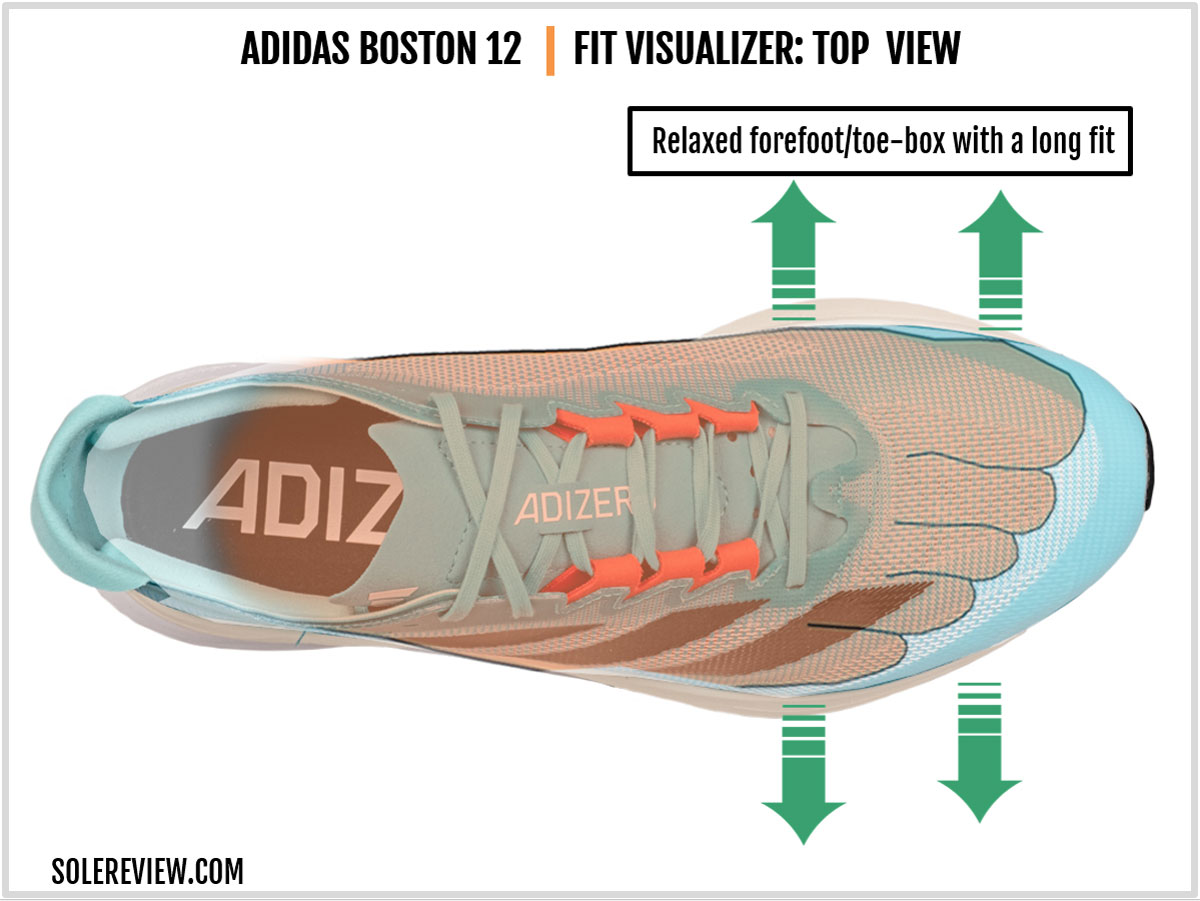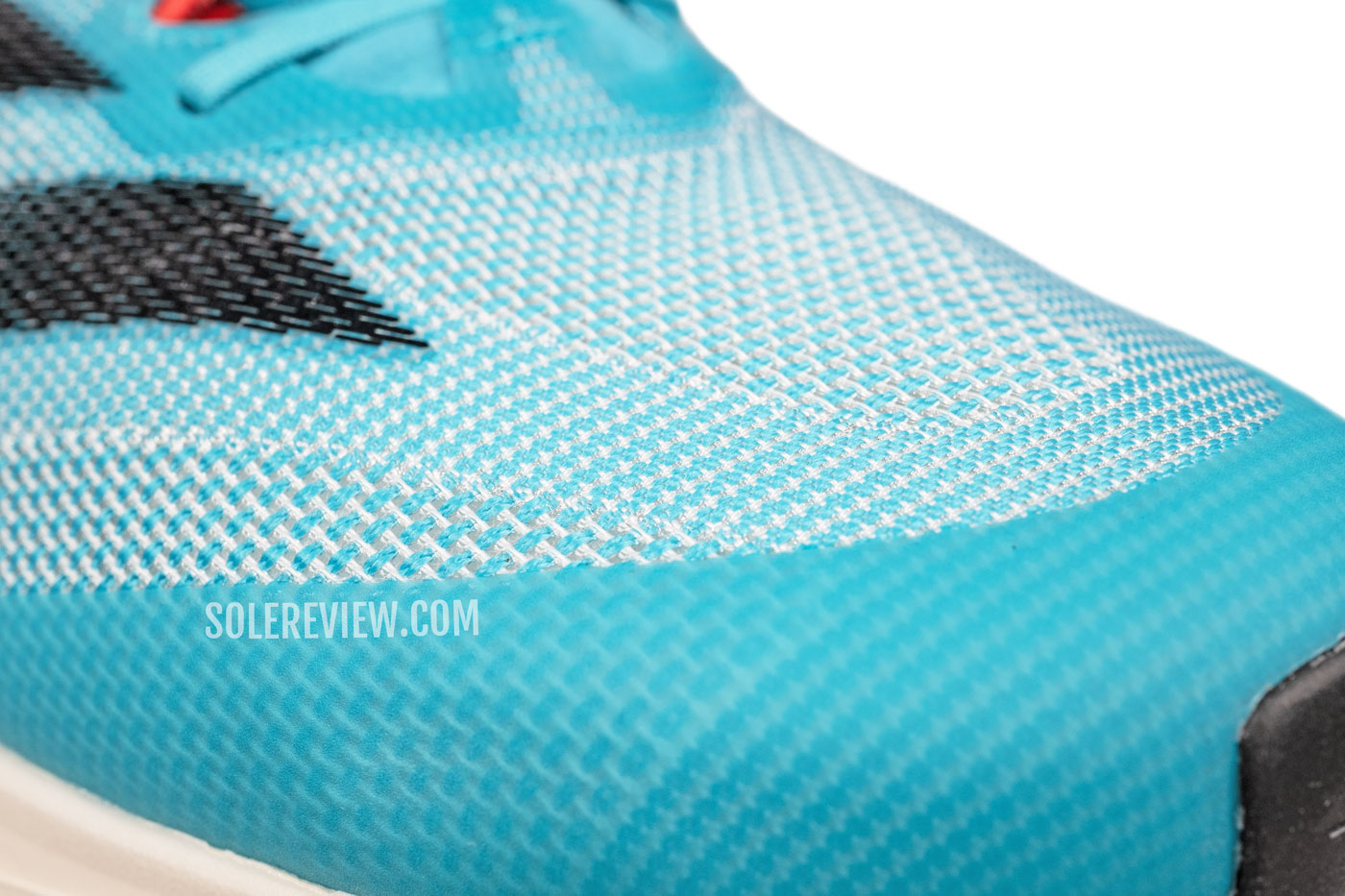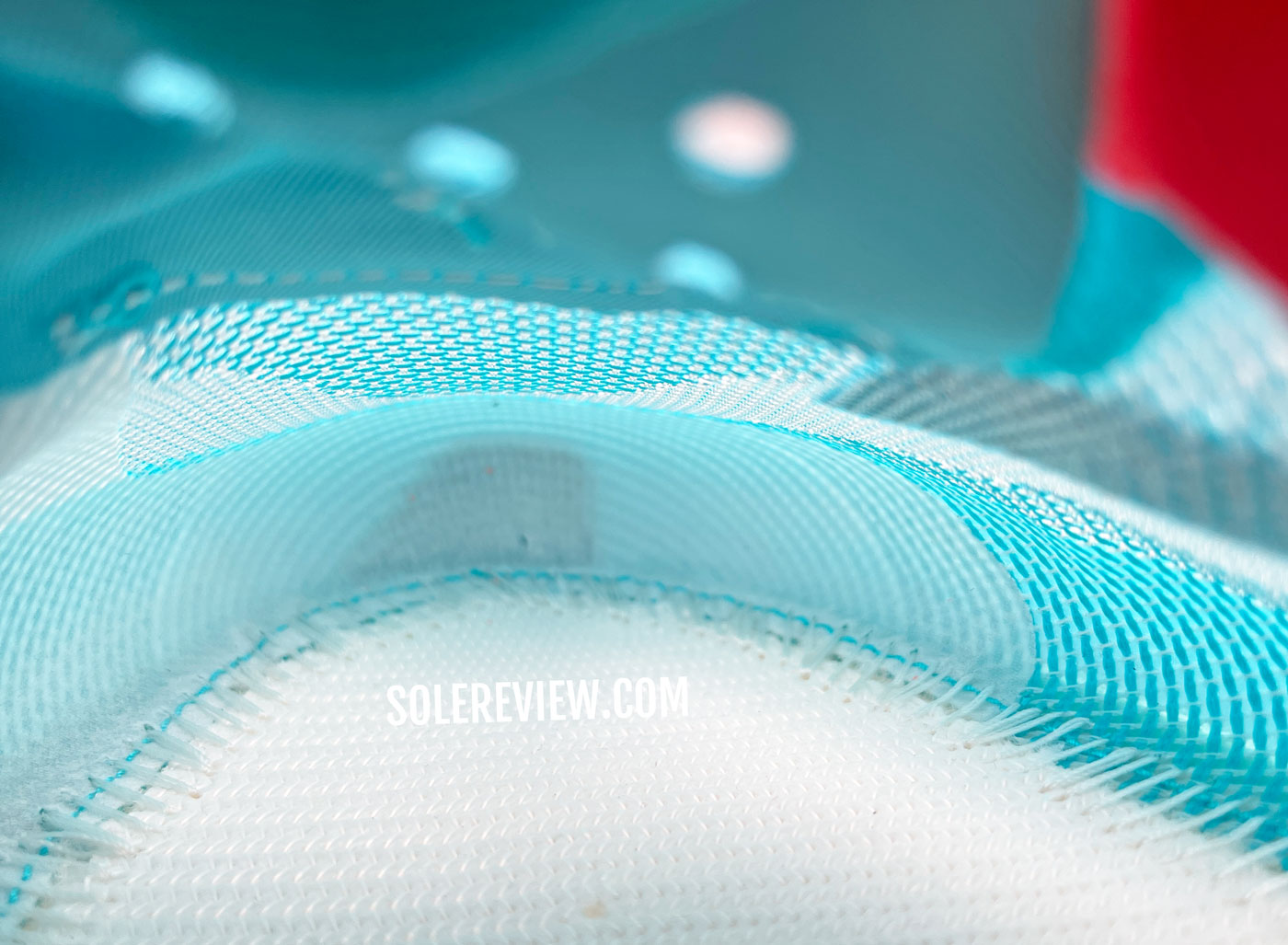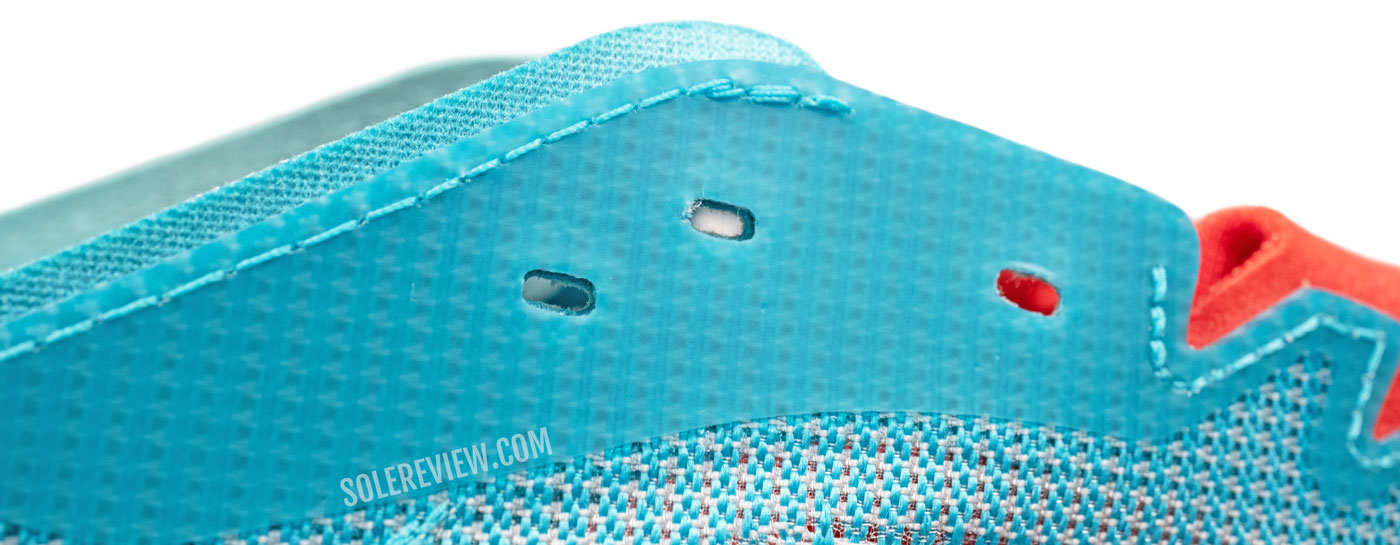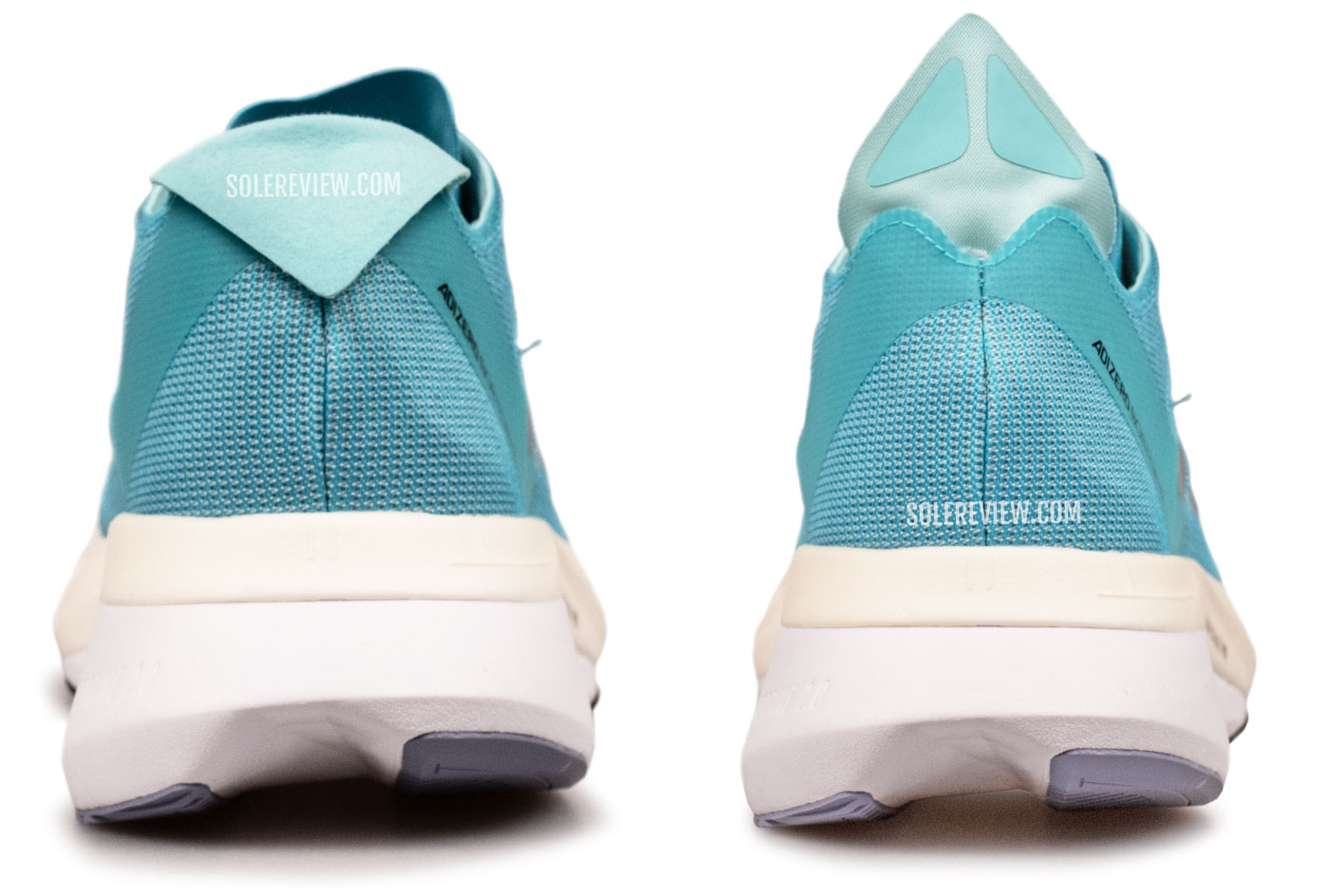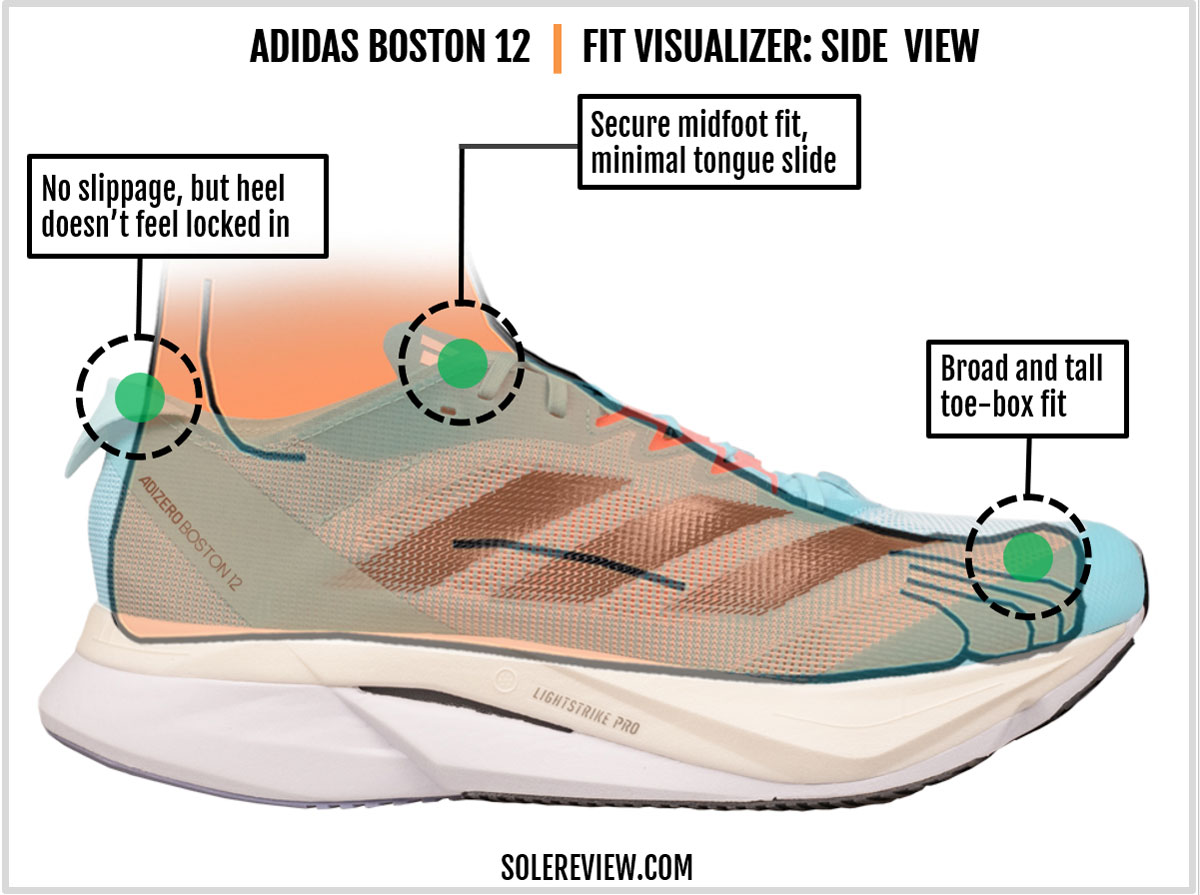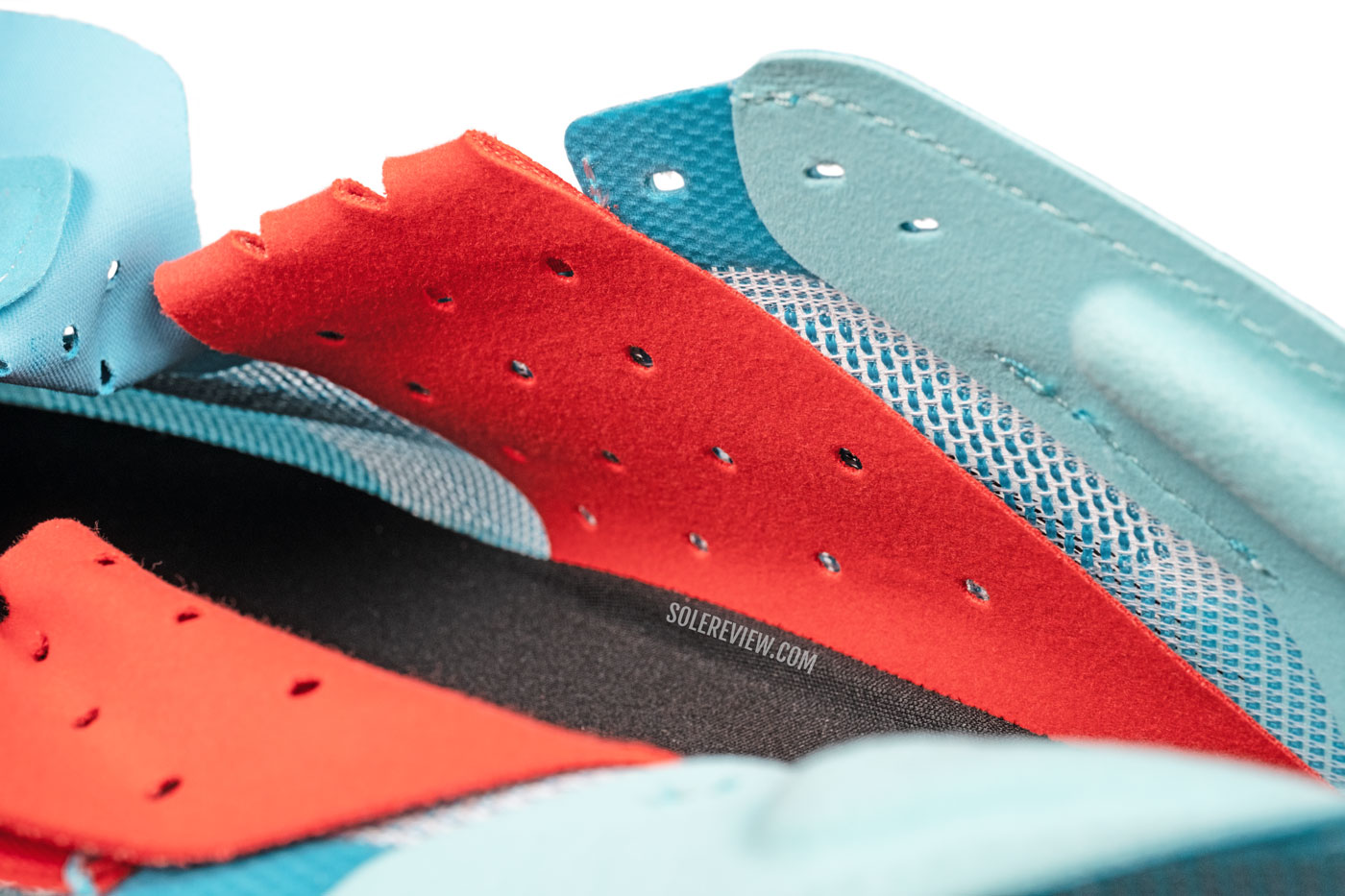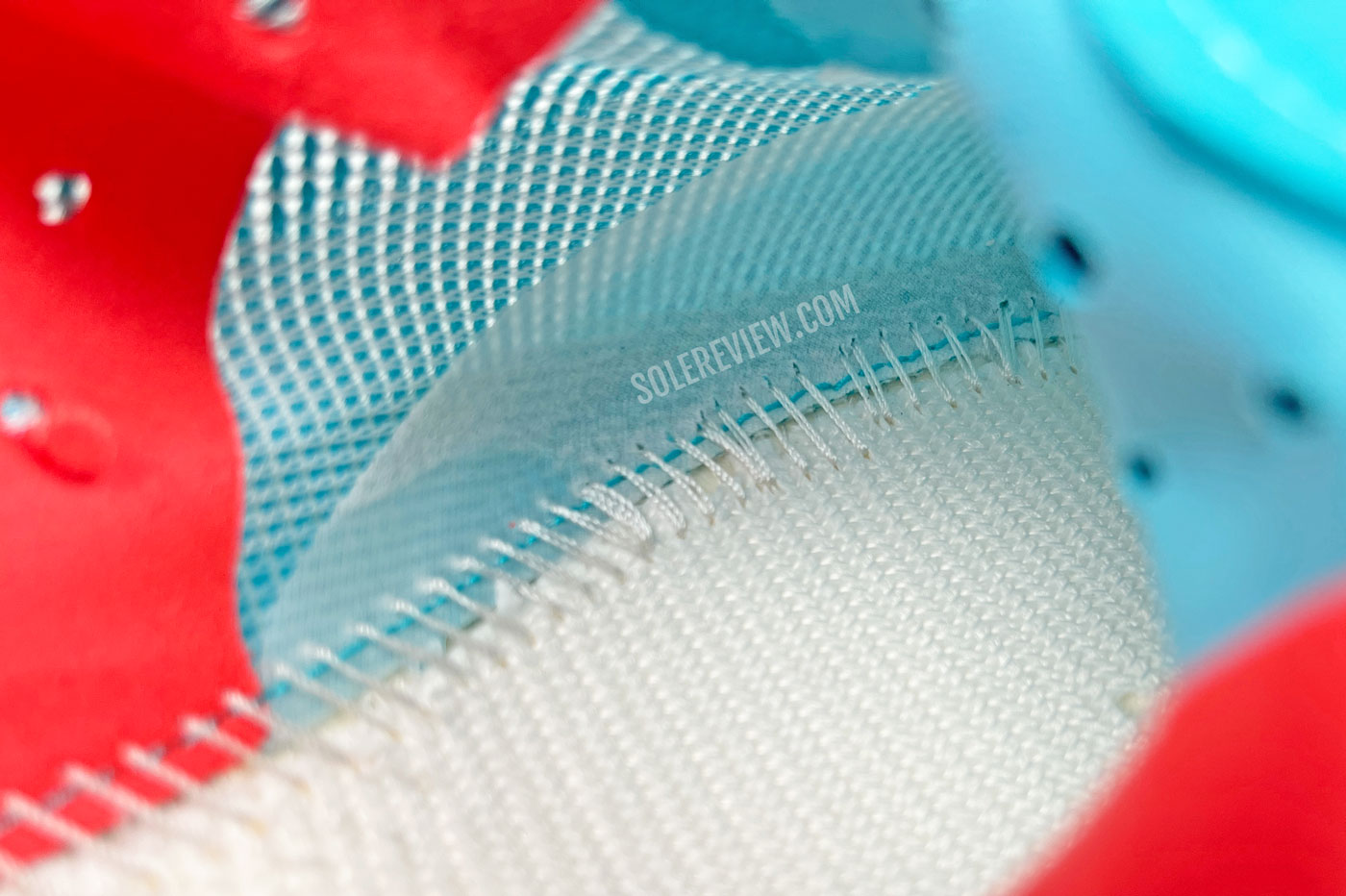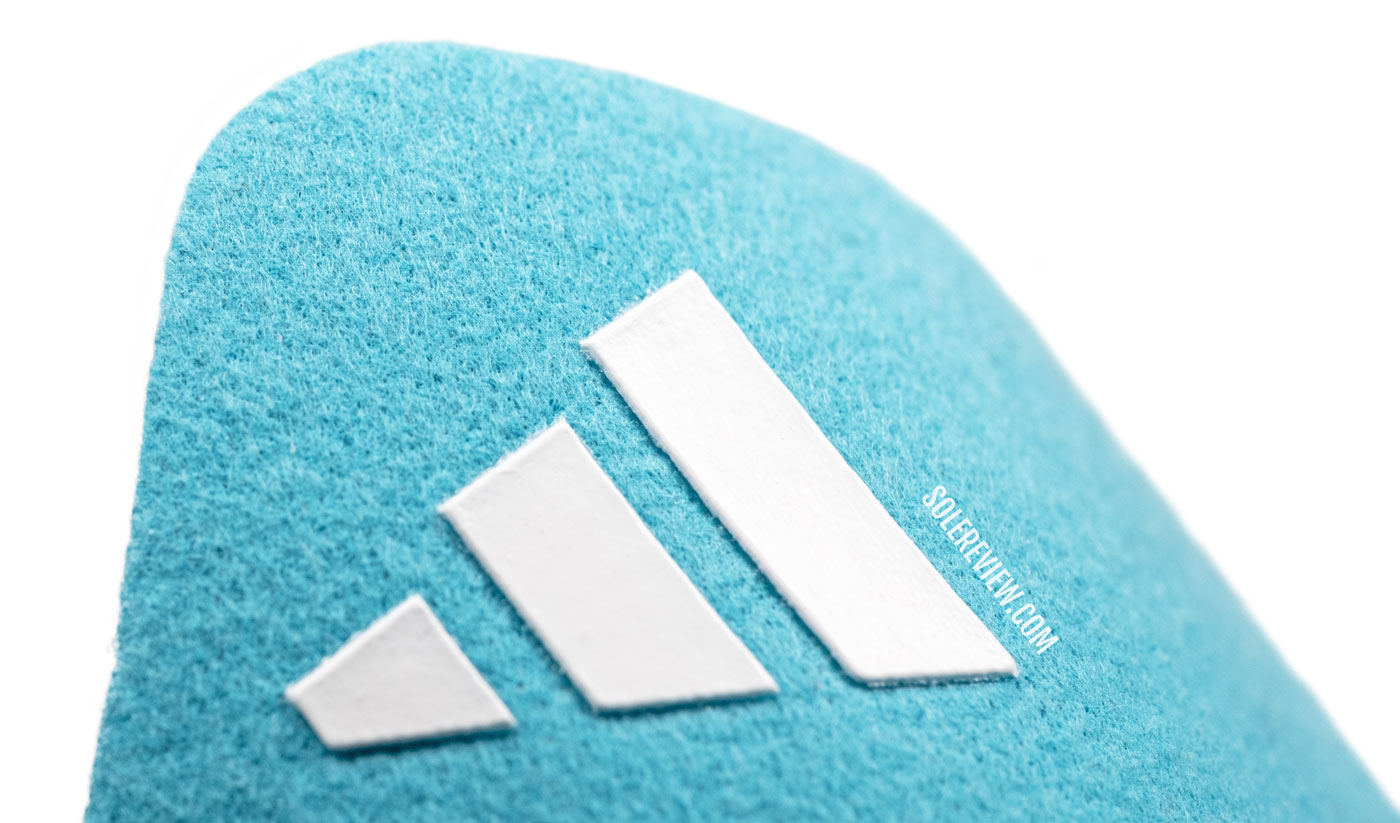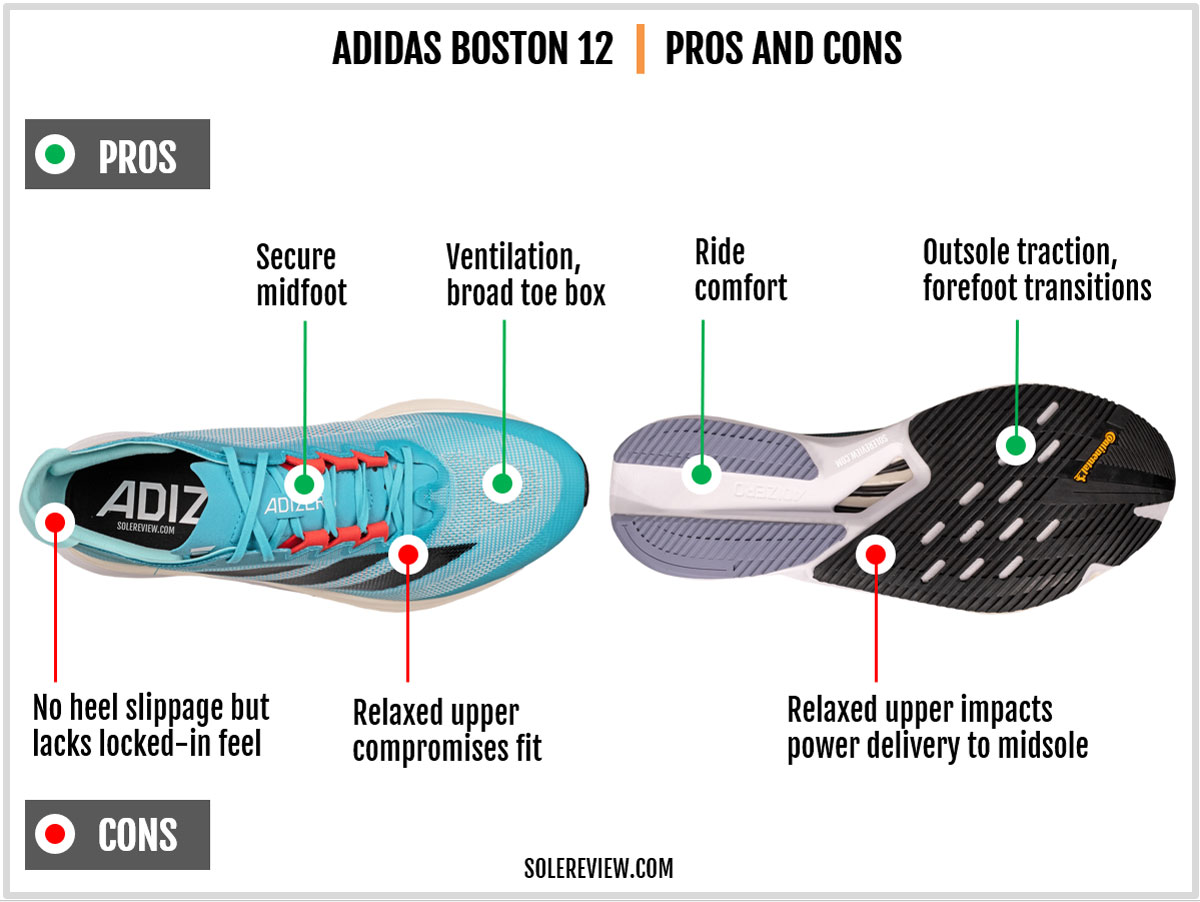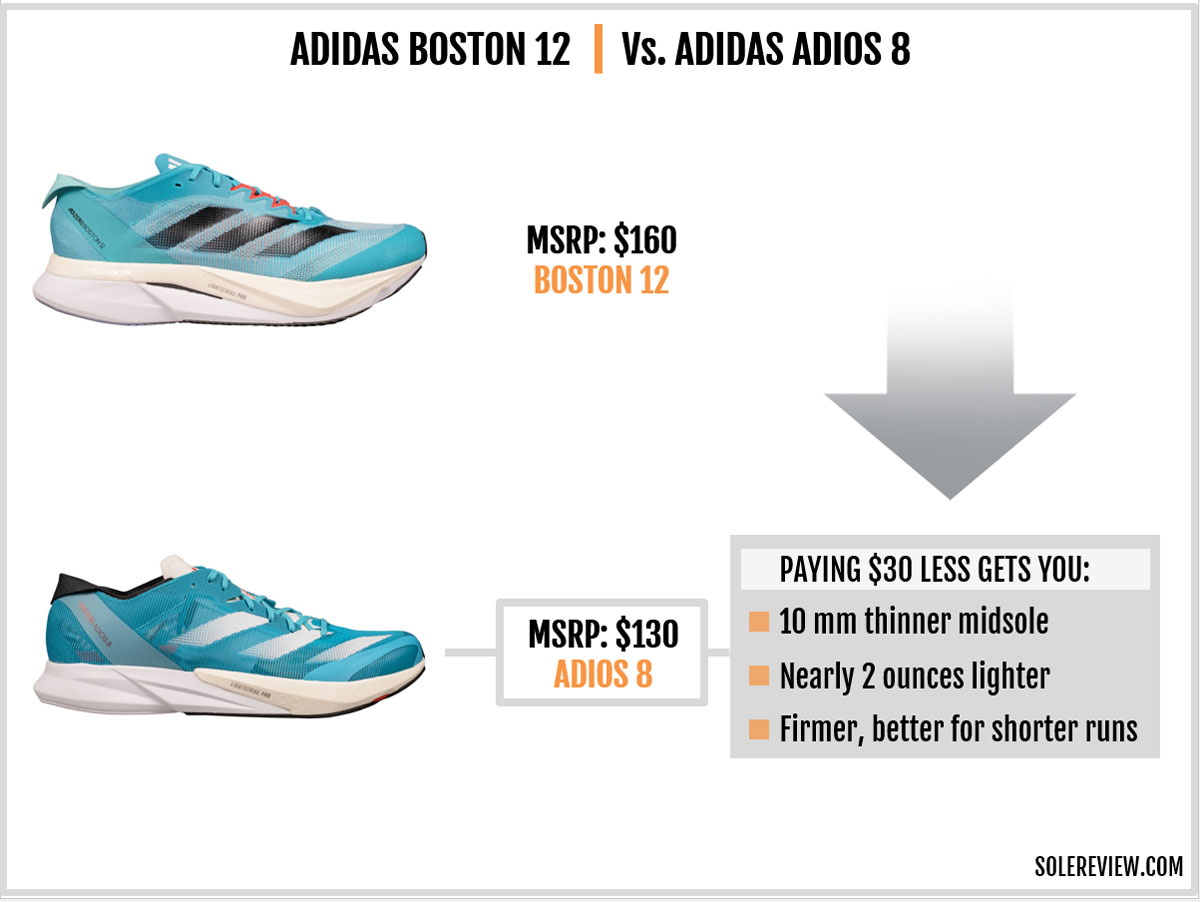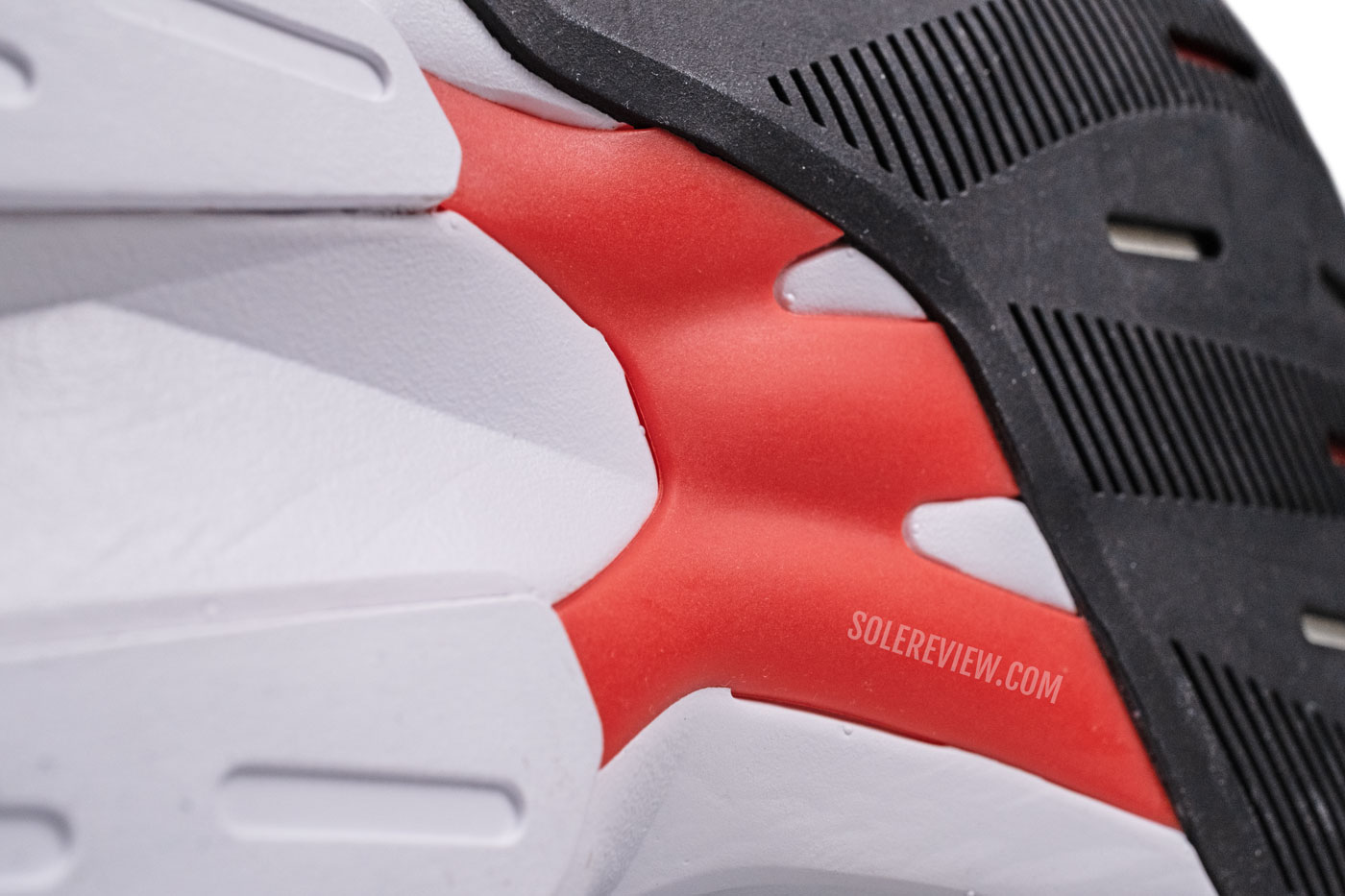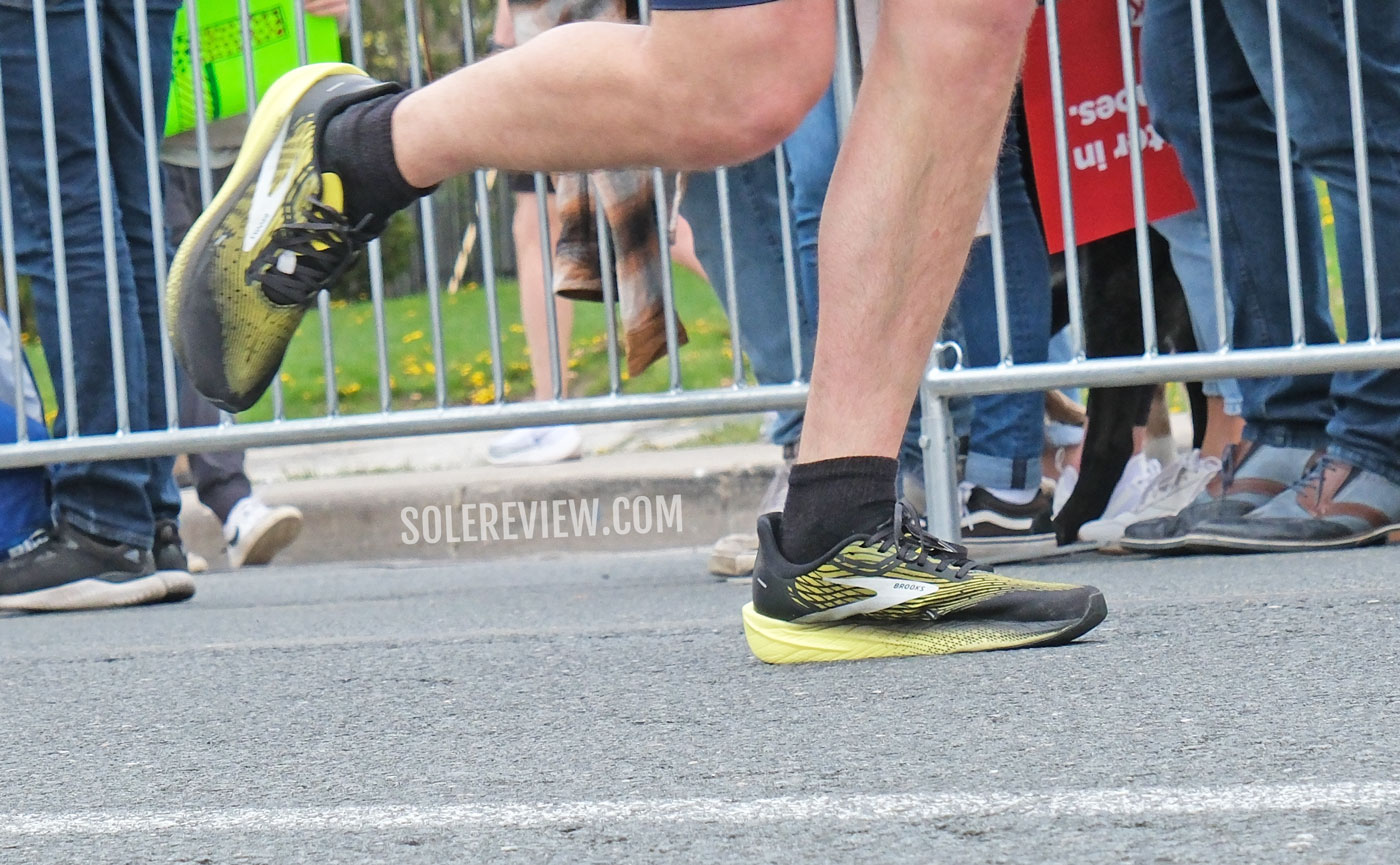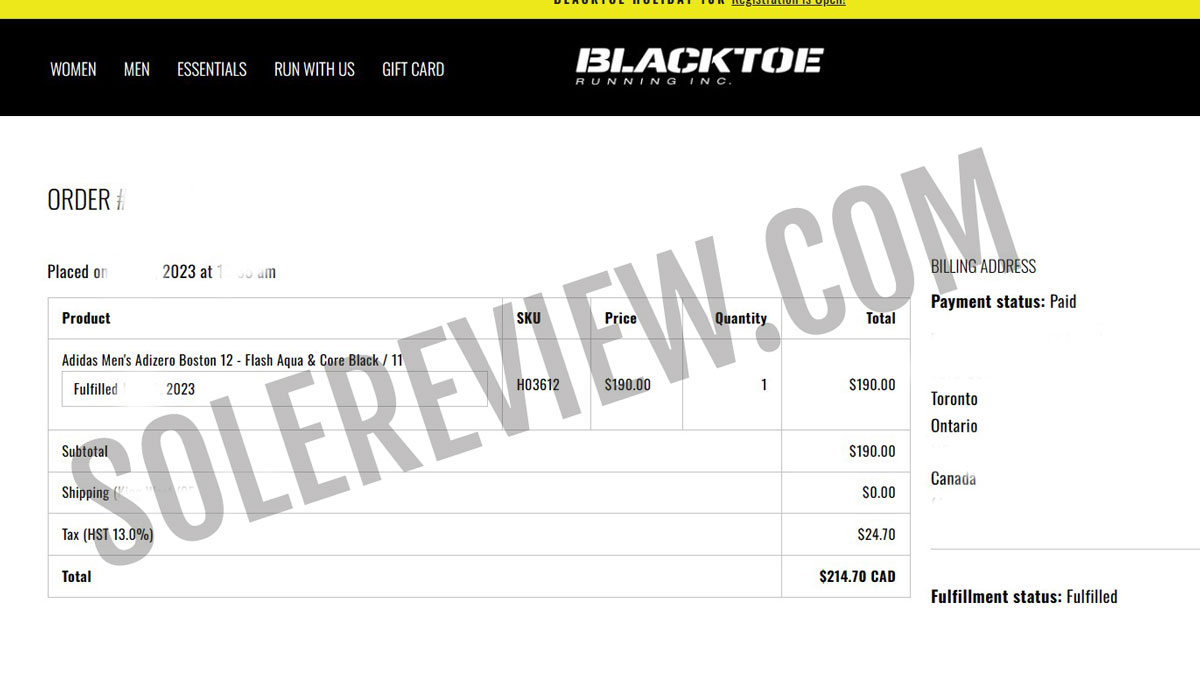
For this review, Solereview paid the full retail price for the adidas Boston 12. The amount is in Canadian Dollars.
In this review:
SUMMARY AND VERDICT
In what was a bold reset of the series, the 2021 Boston 10 transformed into a softer shoe with altered ride dynamics.
The midsole swapped the Boost midsole core for a Lightstrike Pro layer. Inside the midsole were the forked ‘Energy rods’ that guided the transitions, but in a non-controlling way.
The Boston 10 widened its appeal by turning into a softer shoe that was still capable of speed runs. Its taller yet supportive midsole made the Boston a comfortable everyday trainer with decent speed and distance capabilities.
The Boston 11 wasn’t much of a change, considering how most of its parts were borrowed from the Boston 10. However, the looser fit change was noticeable. The forefoot had a longer and more relaxed fit, mostly due to the reworked heel padding that allowed the foot to sit further towards the back.
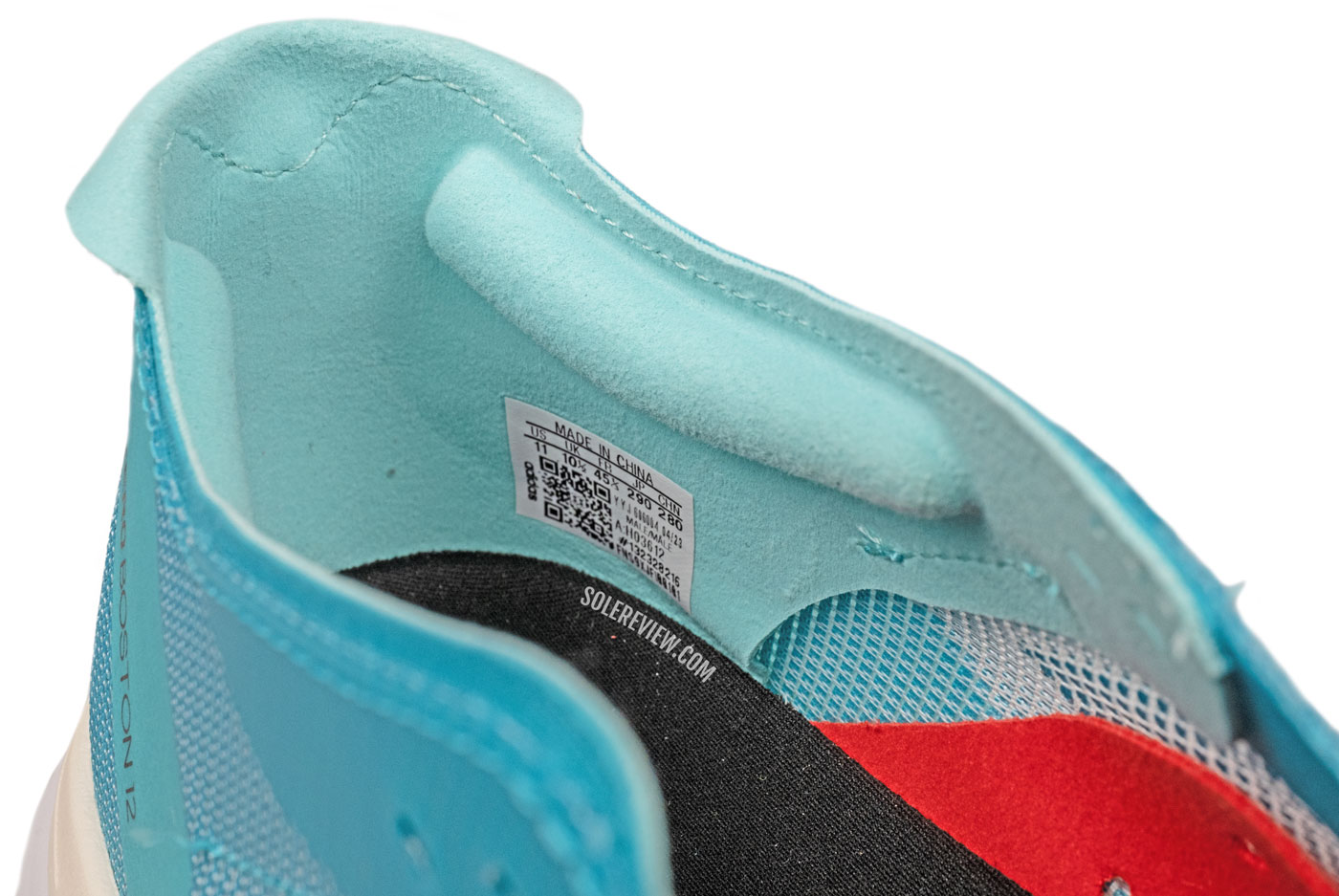
Getting rid of the foam quilting over the Achilles brings the foot closer to the back, leading to a corresponding increase in toe-box space.
Just like the Boston 11, the Boston 12’s heel lacks padding over the Achilles. So the V12 has a very relaxed fit, even more so than last year.
Despite a similar Lightstrike Pro + Energy Rods + EVA midsole setup, the Boston 12 doesn’t behave the same as the Boston 11.
So what makes the Boston 12 different?
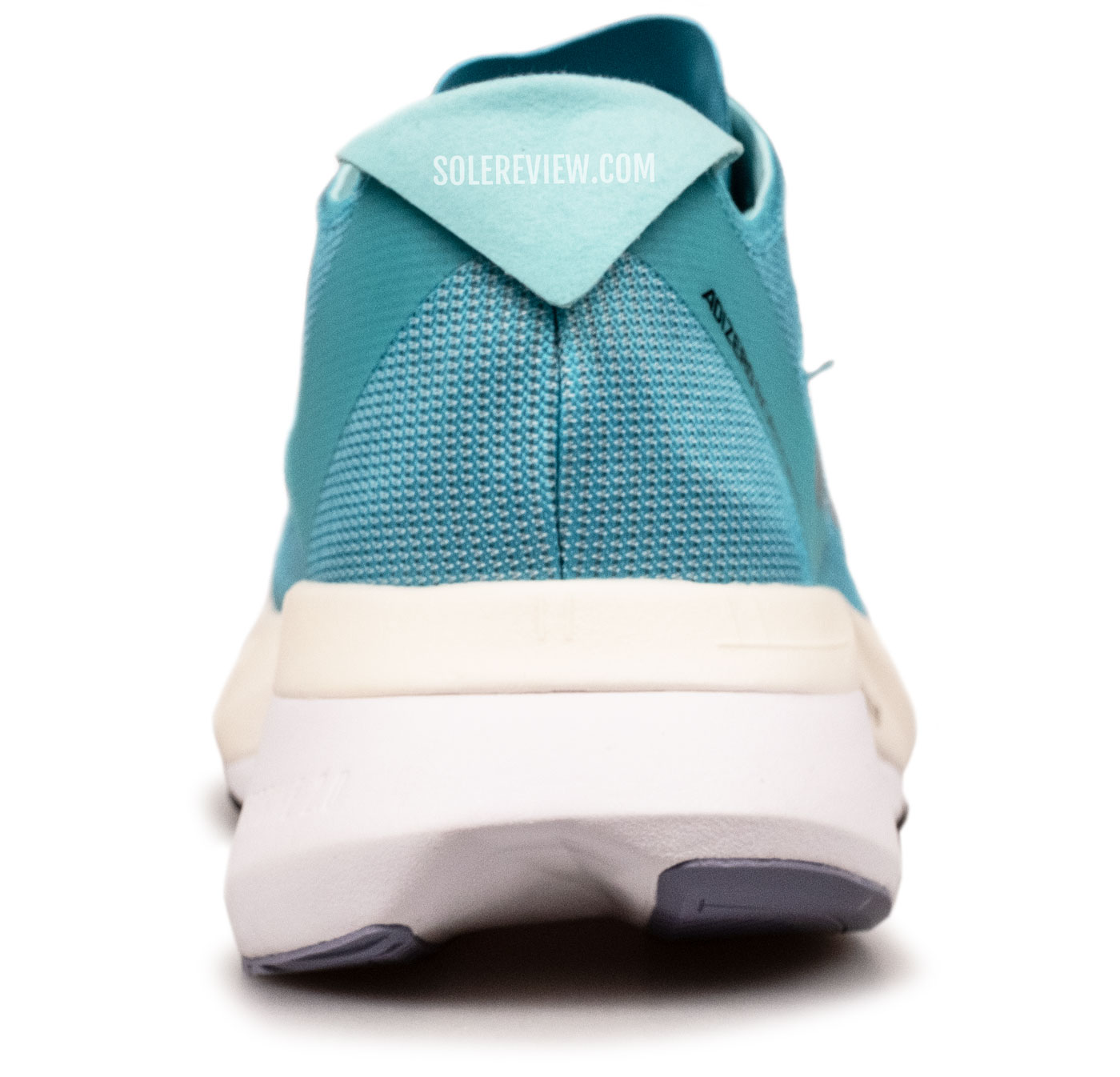
The softer ride (and taller stack) makes the Boston 12 more likable to a broader population of runners.
The reworked midsole is softer, but the upper fit has more say in how the Boston 12 behaves. The relaxed forefoot fit affects the speed capabilities of the midsole.
In return, the Boston 12 makes itself more likeable – in a mainstream kind of way. With a roomy upper and cushioned high-tech midsole, the Boston is now a capable daily trainer rather than being a shoe reserved just for tempo training or races.
On the other hand, runners who were accustomed to the (earlier) Boston’s secure fit will struggle to get a locked-down feel. The foot doesn’t feel completely secure when cornering, as there’s a bit of a sideways slide. A roomy fit on a speed shoe also dilutes the power transfer to the Lightstrike Pro forefoot.
Nonetheless, it’s hard to dislike the adizero Boston and its (newly-acquired) please-all character.
The midsole stacks the Lightstrike Pro foam and Lightstrike EVA foam in a way that’s cohesive in its cushioning delivery. There’s ample comfort for up to a half marathon, and the Energy rods help the Boston keep up with 4:00 min/km (6:30 min/mile) paces.
THE ADIDAS BOSTON 12 COMPARED WITH BOSTON 11
The Boston 11’s fit was longer with more room than the Boston 10, as the heel collar removed the padding over the Achilles. The Boston 12 is based on a similar heel design.
But the Boston 12’s forefoot is more relaxed than the Boston 11, so there’s more than meets the eye.
The first row of lacing starts nearly 10 mm behind where the Boston 11’s lacing began. This means that when pulled tight, the laces do not have the same effect on the forefoot fit as the Boston 11’s lacing.
Also, the Boston 12’s forefoot design is nowhere as busy as the Boston 11, and that too, frees up space. The synthetic suede toe bumper has been exchanged with a fused overlay. This makes the toe-box and forefoot fit wider and taller. The fit is also long – but not quite the half-size difference. Unless you’re running on an incline, that is.
The forefoot cushioning is softer because of two reasons. This time, the forefoot outsole is wider, and so is the midsole above it. The Lightstrike Pro forms a wider base under the forefoot than the Boston 11, and that translates into a softer ride. The outsole is, after all, 5-7 mm broader under the forefoot.
The other reason is the reformulated Lightstrike Pro foam. It’s softer than what the Boston 10 and 11 had.
The roomy interiors produce a slightly inferior transition quality when you’re trying to power through the forefoot. This has to do with how well the foot is locked in over the forefoot; a looser fit is sub-optimal for quick transitions and toe-offs.
Also, a break-in mileage of 30-50 miles is essential on the Boston 12. In the following section, we explain why.
THE MIDSOLE DESIGN AND RIDE EXPERIENCE
What makes any running shoe a good fit for high-speed (4:00 min/km, 6:30 min/mile and faster) runs?
Broadly speaking, such a product would need to fulfill the following criteria:
1. A secure upper that improves the power delivery from the foot to the midsole. A snug upper will lock the foot down over the midsole, thus transferring the power more effectively. This property also benefits cornering abilities.
2. A transition-friendly forefoot for efficient push-offs. This could mean anything from a rocker forefoot that ‘tips’ over the foot forward for quicker transitions, or a midsole made with responsive foam and plate-like inserts. Racing flats with their low-to-the-ground midsoles also fall into this category.
3. A grippy outsole that completes quick turnovers without wasting energy.
The adizero Boston 12 meets criteria 2) and 3) but comes up short in 1). So while it does work as a speed trainer, the overall character is very daily wear-friendly. The Lightstrike Pro forefoot and articulated Energy rods do exactly what they’re supposed to – they make the landings and push-offs comfortable while reducing the workload on the foot.
Unlike stiff Carbon plates, the Energy rods never try to take control of the ride experience, but rather blend into the background. It lets the runner manage the transition process.
The five tubular rods under the forefoot provide that ‘extra’ impetus that would otherwise be missing in an all-foam midsole.
The Boston 12 has an average rocker angle, and the fork-like Energy rods allow the foot to push off using the toes – rather than merely rolling the foot forward as many rocker midsoles do.
On a related note, the Boston 12 needs a break-in mileage, something that did not apply to the Boston 10 and 11 – at least not to this extent.
After 30-50 miles, the forefoot feels softer than on day 1. So why does this happen?
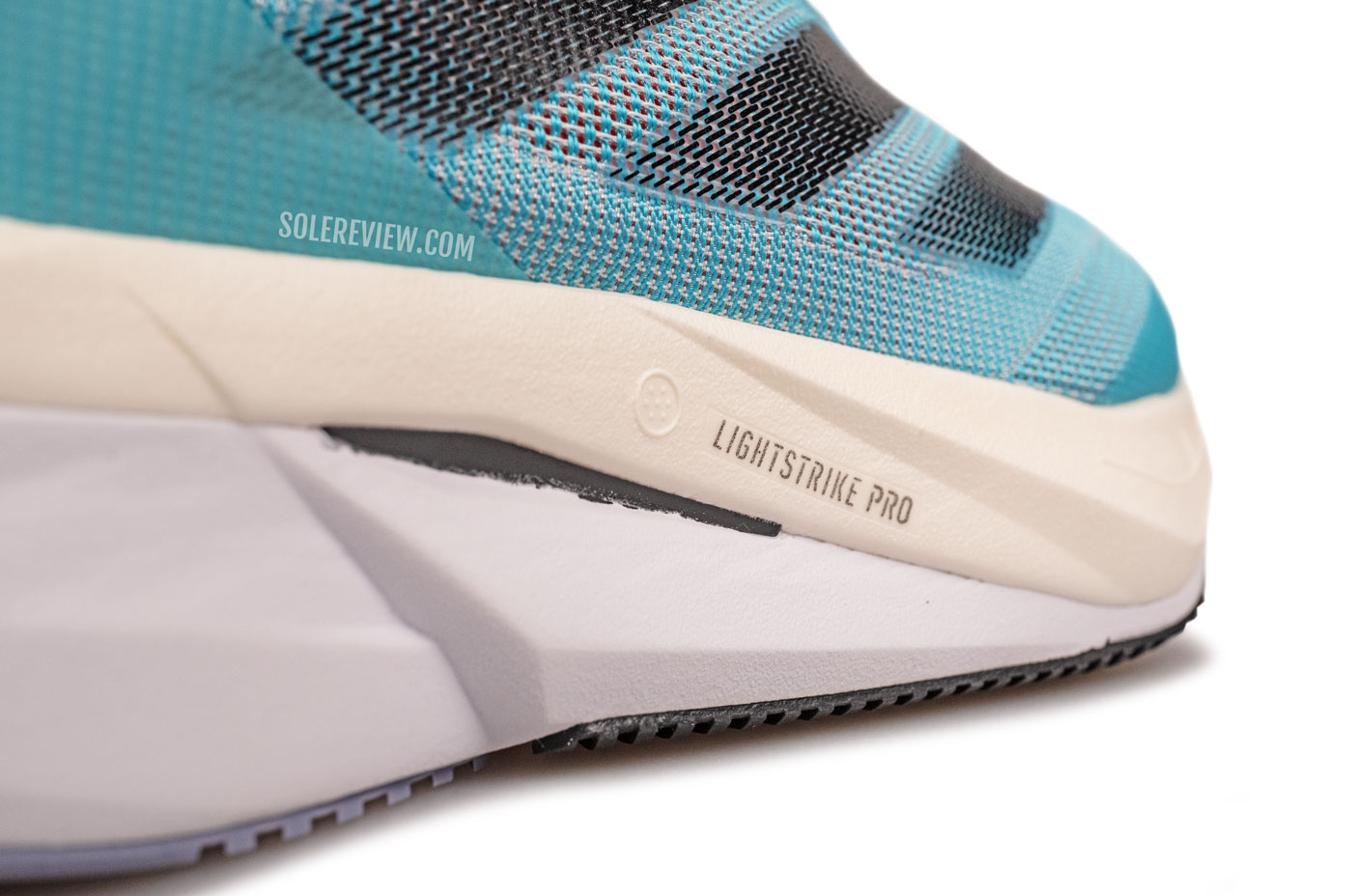
The Lightstrike Pro foam is soft right out of the box. However, the Energy rods need around 50 miles to bed in.
Contrary to popular belief, the soft Lightstrike Pro foam doesn’t require any break-in time. It’s good to go right out of the box. However, it takes a while for the Energy rods to bed in.
The Lightstrike Pro foam on this version is softer and higher volume than last year. That means that there’s a greater variance in the stiffness between the LS Pro foam and Energy rods. On the Boston 10 and 11, the firmer LS Pro foam allowed the stiffer Energy rods to blend in.
Things are different this time. With a softer Lightstrike Pro core, the stiffness of the Energy rods affects the overall midsole softness in the first few days of ownership.
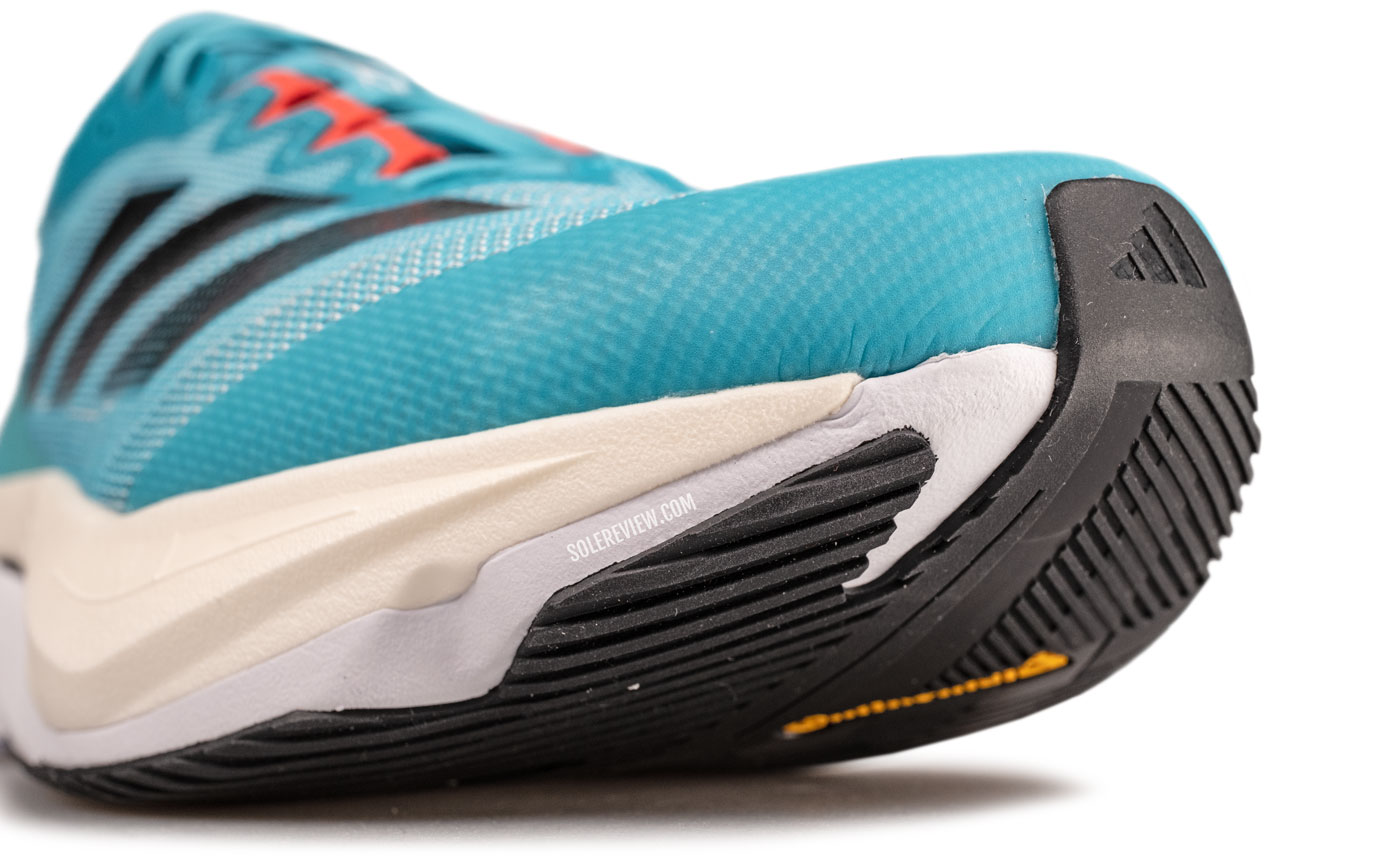
Over time, the flexing resistance of the Energy rods decreases, and that brings out the softness of the LS Pro foam.
Over time, the repeated flexion of the rods makes it easier to bend. The decreased resistance from the Energy rods allows the softness of the Lightstrike Pro foam to surface. The perforated outsole also takes some time to ease in. Unlike the Boston 11’s two-piece forefoot outsole, the Boston 12 uses a single slab of rubber.
This behavior usually applies to shoes with midsole components that mix semi-stiff components with softer parts. The older Mizuno’s were good examples of such running shoes.
To a lesser extent, the break-in also applies to the rearfoot where the Energy rods loop in a nested coil. But with Lightstrike EVA foam being firmer than the Lightstrike Pro forefoot, the break-in process isn’t as lengthy. The coils are also easier to compress than the Energy rod tubes under the forefoot.
The wider and softer midsole makes the Boston 12’s character more malleable and versatile. While it’s not the speed shoe it once was, the Boston 12 is now comfortable and spacious enough to be an everyday trainer.
The Boston 12 has generous stack heights of 38 mm (heel) and 31 mm (forefoot), so there’s cushioning comfort regardless of how one lands.
However, as most of the forefoot is the superior Lightstrike Pro foam, there’s a difference in how the shoe feels under the forefoot. The forefoot cushioning is far more nuanced.
Under the heel, most of the stack is comprised of the Lightstrike EVA foam and removable insole. The LS Pro foam layer is just a thin slice, as most of the LS Pro you see from the outside is the sidewall or ‘cup’ and not the effective thickness.
The difference in the softness between the heel and forefoot isn’t noticeable, but the cushioning quality is.
Under the forefoot, you can feel the springy and resilient LS Pro pushing up against the feet; whereas under the heel, it’s conventional softness with a bit of pop. The Energy rods coil under the heel, and that’s what makes the ride snappy – not the LS Pro foam.
Having a long EVA foam wedge under the LS Pro foam has its advantages. For one, it makes the Boston 12 fairly supportive. The angle of the heel bevel is higher on the outer side, so that creates a minor cushioning bias.
A firmer foam layer also keeps the cushioning from bottoming out. Shoes like the adidas Takumi Sen 9 and Nike Streakfly do that to some extent when fully loaded. Several layers separate the foot from the road, so the midsole is very protective.
Like most shoes from the adizero line-up, the Boston 12 works equally well for rearfoot strikers as it does for forefoot strikers. Also, relaxed paces (5:30 min/km, 8:50 min/mile and slower) are doable without incurring a performance penalty.
There’s a lot of outsole for the Boston 12’s 9.2-ounce (261 grams) weight. The trusty Continental rubber outsole covers the underside of the forefoot, and the overall traction is excellent even on damp roads. The outsole doesn’t have the rib-like lugs of the Boston 10 and 11, but that doesn’t affect the grip quality.
There are no flex grooves, but the perforations make it easier for the outsole to work together with the midsole.
And why isn’t the Boston 12 a ‘true’ speed shoe? The upper doesn’t have the secure lock-down of the Boston 10 (the Boston 11 had more room), so the shoe struggles during corners.
Even during straight-line runs, the foot shifts a little when executing quick touch-and-go at quicker (4:00 min/km, 6:30 min/mile and faster) speeds. The roomier fit makes it harder to isolate the responsiveness of the Lightstrike Pro foam.
That’s one of the reasons why we loved the New Balance SC Elite V3 – the snug yet comfortable upper made it easier to transfer power to the midsole. Not that it’s directly comparable to the Boston 12, but the SC Elite 3 is a good example of how the upper fit influences the midsole responsiveness.
Most people will reap the benefits of a more relaxed fit. It’s easier on the feet during a long run – after all, the Boston 12 is cushioned enough for half-marathons and longer.
One last thing. The midsole has a slim waist, so the midsole edge curves under the arch. When trying on the shoe for the first time, some runners may feel a mild pressing sensation against the arch. This will be barely noticed during runs, as the soft Lightstrike Pro foam does not create a hot spot.
RECOMMENDED ROTATION
adidas hasn’t figured out their daily trainer assortment yet, so for now, the Boston 12 works perfectly well for that use case. Thanks to its spacious fit, soft ride, and durable build, the Boston is more mainstream than ever.
For marathons, the adios Pro 3 is your best adidas pick. There’s the Prime Strung X2, but the question is – do you need that much shoe? The PSX 2 is pretty heavy too. Instead of the adios Pro, either the Nike Vaporfly 3 or Saucony Endorphin Speed 3 will also work.
Shoes like the adidas adios 8 and Brooks Hyperion are a better fit for short-distance races (10K and below), intervals, and such. Both shoes are matched on stack heights and weight, with the adios 8 having a slight edge on outsole durability and traction.
IS THE ADIDAS BOSTON 12 DURABLE?
Nearly half of the Boston 12’s midsole is made of EVA foam, so the cushioning won’t have the durability of shoes like the adios Pro 3.
But that’s purely in relative terms. Even with the eventual cushioning degradation that comes with EVA, the Boston should last for 450 miles or more.
Some cosmetic creasing will develop over the EVA foam (rear) section of the midsole in the first 30-50 miles, but that doesn’t affect the ride performance.
THE UPPER DESIGN AND FIT
Many runners will find it difficult to get a properly locked-in fit with the Boston 12. The excessively roomy forefoot affects the overall fit.
Any change in the heel design has a corresponding effect on the forefoot fit, and this is one of the many things that shoe brands overlook during a redesign.

The Boston 12 has the same collar pod design as the Boston 11 and adios Pro. By letting the foot sit closer to the back, the upper fits longer than it should.
Perhaps, adidas did not take the effect of heel redesign (on the overall fit) into consideration before it changed the Boston 11’s (and adios 7’s) upper design. Just like the Adios Pro, the heel has two foam pods but no padding on the base of the heel. The Boston 12 and adios 8 use a similar design template.
This causes the foot’s position to move rearwards by at least 5 mm, thus increasing the sizing length.
adidas has also replaced the suede overlays with an externally fused toe bumper. This creates a broader and taller toe-box fit.
As for the heel fit, there’s no slippage per se; a stiff counter keeps the heel in its place. But there is a ‘sensory’ gap over the Achilles where the foam padding on the Boston 10 used to be. This gap of 5-ish millimeters results in a longer and looser fit.
We also like the foldable heel pull tab that can be tucked away over the heel during runs. The rubberized print is meant for grip and isn’t reflective.
The Boston 12 is true to size, but that’s cutting it close. The sizing also depends on whether you’re running uphill or downhill.
On a steep incline, the heel gets pushed back into the vacant space between the foam pods, and the shoe feels a half size larger than it should be. When going downhill, the Boston 12’s forefoot sizing feels just right. On regular straights, there’s some extra room in front of the toes, but not enough to warrant buying half size up.
Optional widths are not available, but a ‘B’ width would have been helpful.
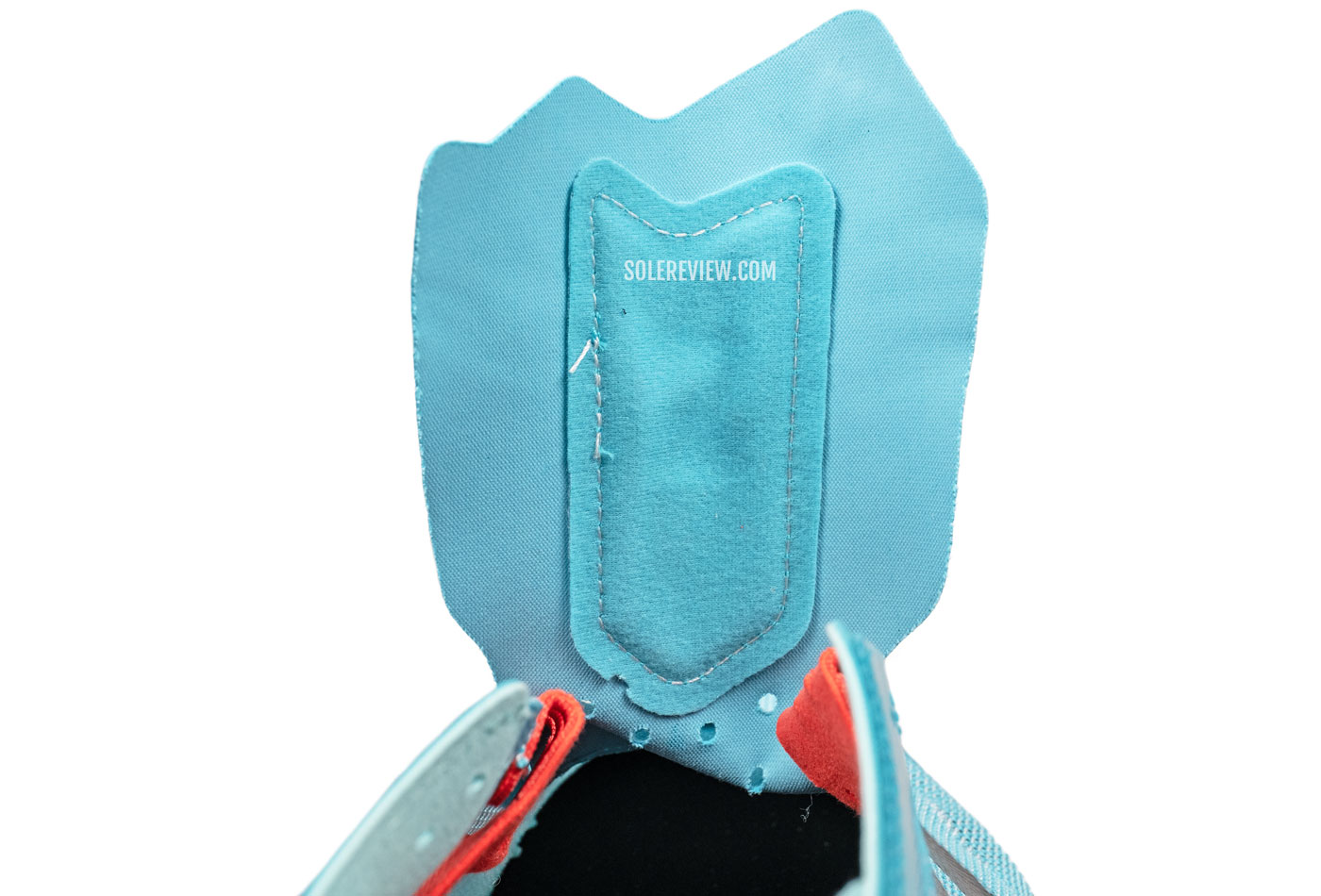
The tongue has a wide flap, but no sleeve. The slide is minimal, and the lining minimizes the lacing top-down pressure.
The midfoot grips well enough. Unlike the adios 8, the Boston 12 doesn’t have an elastic gusset. The lightly padded tongue isn’t attached to the sides, but the lacing loops are. The pair of soft midfoot saddles loop over at the top for the laces to pass through.
The internal arch straps are soft and perforated to prevent the midfoot from feeling stuffy. The Boston 12’s upper breathes very well; the thin mesh does a good job of letting the air pass through.
adidas uses soft synthetic suede for the tongue, so the flap doesn’t irritate the Achilles. The tongue loop on top is covered with the lining to minimize irritation from the laces passing through.
ORTHOTIC COMPATIBILITY
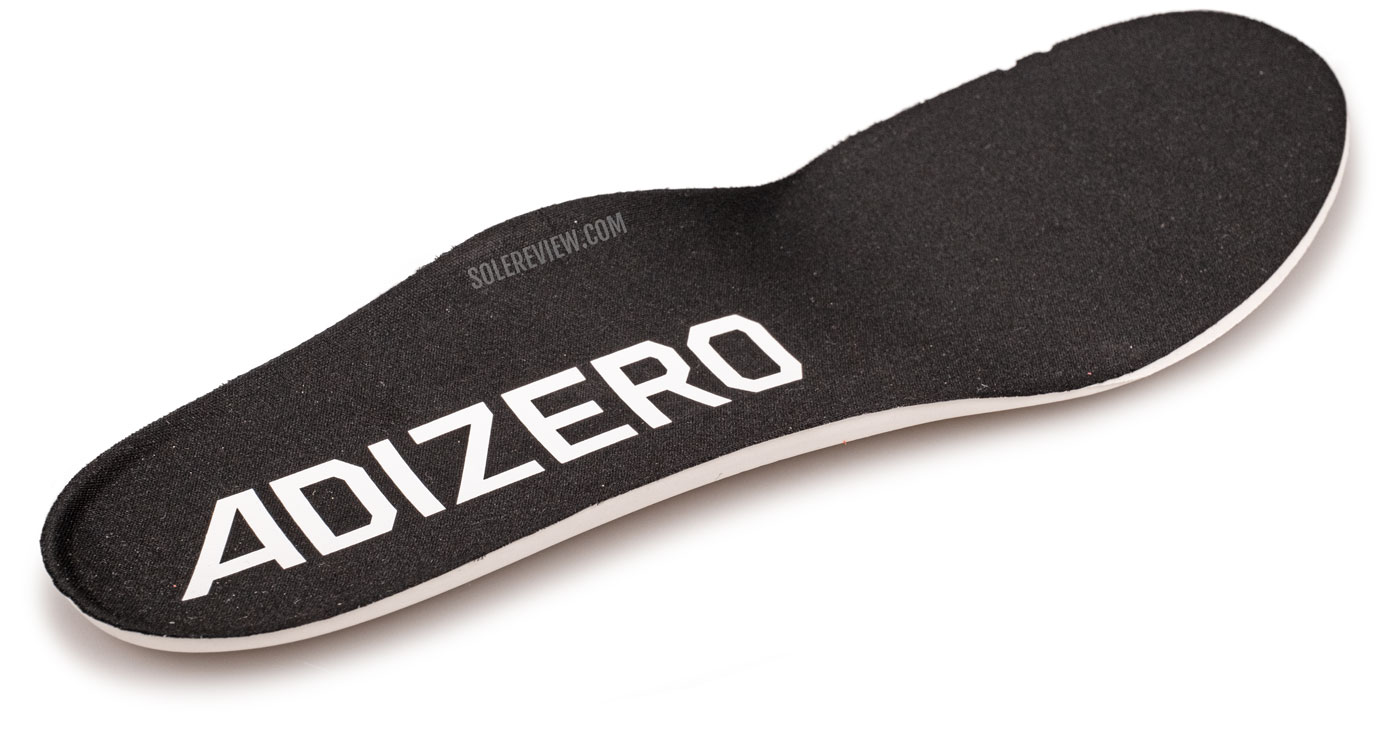
If you’re going to drop an Orthotic into the Boston, having a matching thickness as the soft insole will produce the best results.
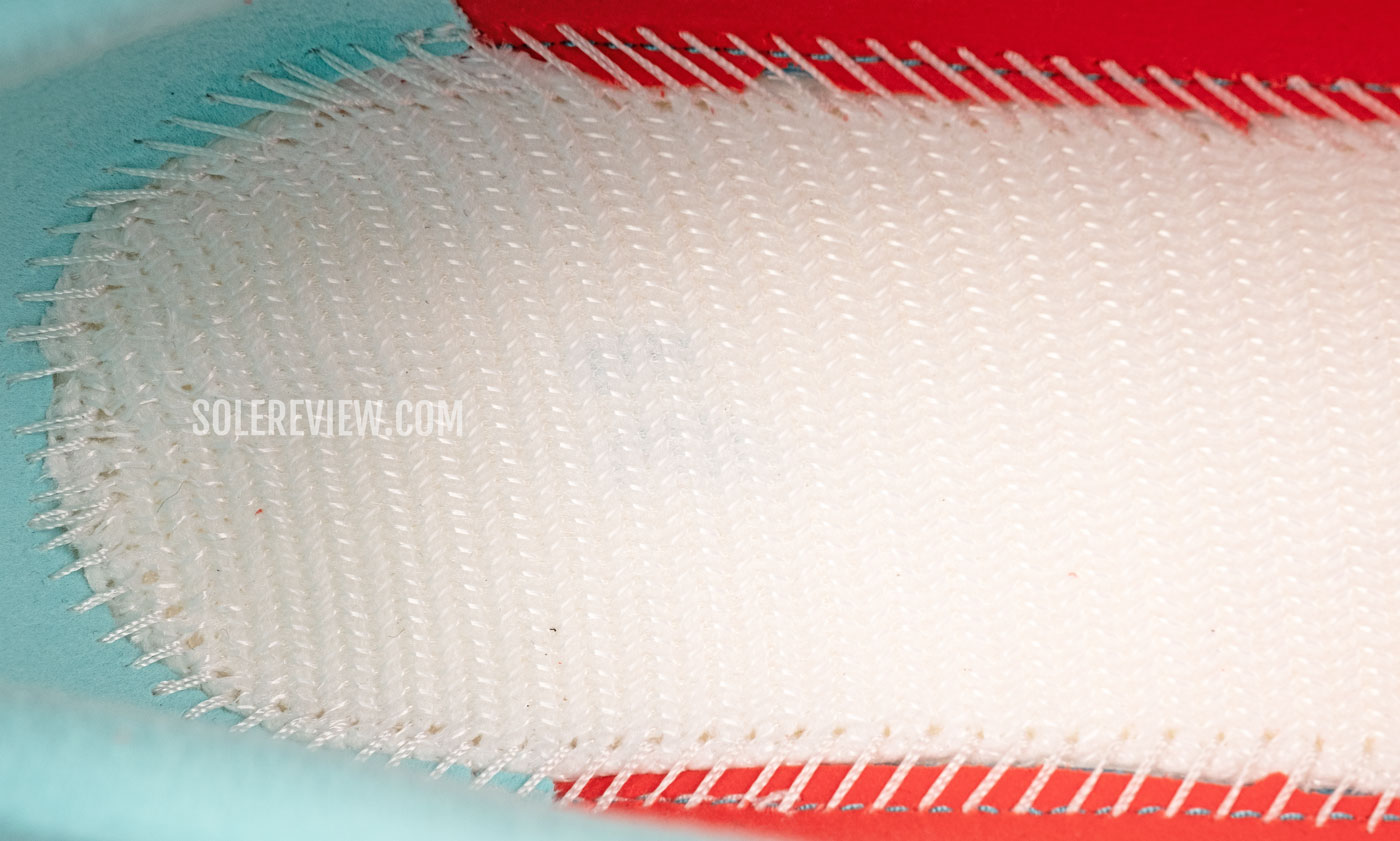
A stiffer aftermarket footbed will decrease the step-in softness. The Boston doesn’t have an EVA foam Strobel, but rather a fabric lasting.
The footbed of the Boston 12 is a removable kind, but it isn’t thick. That’s a limiting factor when using aftermarket insoles, so the Boston 12’s overall orthotic compatibility is low.
PROS AND CONS
The relaxed upper fit isn’t a ‘con’, but it feels out of place on a shoe that is meant for faster speeds. As we said, adidas likely misjudged the effect that the new heel pod design would have on the forefoot fit.
COMPARISON: THE ADIDAS BOSTON 12 VERSUS ADIDAS ADIOS 8
The adios 8 (our review, here) is a much lighter shoe that works better for shorter speed runs than the Boston. The stack heights and overall weight makes a huge difference; the 7.3-ounce adios is nearly 2 ounces lighter than the Boston 12. The upper fit is snugger as well.
Those weight savings come from a significantly lower midsole stack height. The adios is 8 mm less thicker under the heel and 11 mm lower in the front. The low-profile midsole makes the transitions more efficient by creating a closer connection with the road.
The thinner forefoot allows the toe-offs to be more effective, as the foot spends less time working its way through the foam stack.
And while the plastic shank forks into three under the forefoot, it doesn’t have the same effect as the Boston’s Energy Rods. They are also placed below the LS Pro foam instead of being embedded within.
The adios doesn’t quite have the propulsive feel that the Boston has; while the shank extension gives the forefoot a nice snap, it doesn’t have the roll-forward effect.
It’s best to limit the adios 8 to 10k runs and shorter, because the thinner midsole isn’t as forgiving as the Boston.
SHOES COMPARABLE WITH THE ADIDAS BOSTON 12
The Brooks Hyperion Max is an option if you prefer a rocker midsole without any internal components like a plate or rods.
Not only is the H-Max significantly lighter (7.8 ounces, 221 grams), but it also has a similar heel drop of 8 mm. The midsole is around 4-5 lower than the Boston, though. Like the Boston, the Hyperion Max is a speed trainer that doesn’t beat the foot down, be it a 10K race or a half marathon.
New Balance has updated the Rebel V4 with numerous changes, the headlining act being the new midsole with a rocker. We haven’t tested the Rebel V4 yet, but we imagine it being comparable to the Boston 12 – likely more so than the Rebel V3.
If you’re struggling with getting a locked-in upper fit on the Boston 12, give the Asics Magic Speed 3 a go.
The upper fit is more dialed in, and it’s priced the same as the Boston 12. The Magic Speed is the only shoe in its price class with a full-length Carbon plate. The midsole is fairly thick, so there’s plenty of cushioning in the tank for up to a half marathon.
Do you own this shoe? Improve this review by sharing your insights.

